Posts Tagged ‘Holocaust fraud’
Tuesday, May 1st, 2012
By Carolyn Yeager
Updated on May 2, 6:30 p.m. (see below)
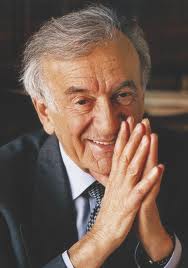
Robert Ransdell is a man after our own heart. He’s putting up money to publicize the fact that Elie Wiesel doesn’t have the Auschwitz tattoo he claims to have.
“An Evening with Elie Wiesel” is coming to Xavier University in Cincinnati, Ohio, Sunday, May 6th. The entertainment/education event is being marketed by CHHE, which stands for Center for Holocaust and Humanity Education. We just finished with Holocaust Remembrance Week in the United States, and now the entire month of May is Jewish American Heritage Month! So people like Elie Wiesel are on the circuit.
Picture at right is used on promotional materials for the “Evening with Elie Wiesel.”
CHHE is worth studying in itself. It shouldn’t pass your notice that “Holocaust” is combined with “Humanity,” cleverly making a connection between the two. Headquartered in Cincinnati at the campus of Rockwern Academy (formerly Yavneh Day School) at 8401 Montgomery Road, Cincinnati, OH 45236, it displays a permanent exhibit named Mapping Our Tears which showcases “a multimedia theater set in a 1930’s European attic that takes visitors back in time.” A portable exhibit of “Out of the Attic” can be taken to schools and other locations (with trained “educators,” of course) for a fee of $350.00 a half-day and $500.00 for a full day. But Mapping Our Tears is also supported by generous benefactors, such as United Way, U S Bank, Time-Warner Cable, Kroger, Proctor & Gamble, Cinergy, Federated Dept. Stores and Frisch’s Big Boy … and one whose logo I can’t recognize. (Anyone in the mood to boycott?) To see the permanent exhibit, it is suggested you give a “donation” of $5 per person. CHHE is a non-tax-paying, non-profit organization … such a laugh.
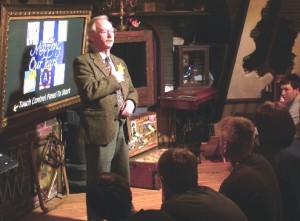 Left: Henry Fenichel, top speaker, wears a yellow Star of David while conducting a presentation to students.
Left: Henry Fenichel, top speaker, wears a yellow Star of David while conducting a presentation to students.
CHHE has a Speakers Bureau, naturally, featuring “Holocaust survivors, Holocaust refugees, World War II veterans and concentration camp liberators, and other eyewitnesses. Additionally, children and grandchildren of survivors, and trained experts and educators are available to speak to your group.” Also, “A donation to the Center of $100 is suggested to cover the costs incurred by this program.” I imagine one would be made to feel downright cheap if an even more generous “expression of appreciation” were not given directly to the speaker also. Elie Wiesel is too exalted to be just another available speaker on their list, and absolutely costs more than $100 (LOL) but he is still handled by the Speakers Bureau.
The Center likes to hold major events at nearby Cintas Center of Catholic Xavier University. In the new spirit of Catholic-Jewish reconciliation, the Jesuit university is more than willing to help promote holocaust education. But does the Jewish school or the Hebrew Union College-Jewish Institute of Religion in Cincinnati (which used to house the CHHE) promote Catholic-Christian history in a way that the Catholics would like? Very doubtful. With Jews, you don’t get an equal exchange.
The poster that advertises the event says “Professor Wiesel’s visit is made possible by The Jewish Foundation of Cincinnati … with their partners The American Jewish Committee, Cedar Village, Jewish Community Relations Council, The Jewish Federation of Cincinnati, Jewish Vocational Service and the Issac M. Wise Temple. In other words, it’s an all-Jewish production. It is Jews, and Jews alone, who present endless programs on the Holocaust to the long-suffering Christians, although the audience will probably be majority Jewish. They make sure to support their own.
Note that there is both a Jewish Foundation of Cincinnati and a Jewish Federation of Cincinnati. The CHHE reminds me of the British HET (Holocaust Education Trust). I feel sure it is patterned after that older, very successful organization.
The man who is sponsoring a $1000.00 Challenge to bring the ‘Wiesel—No Tattoo’ issue to the Xavier campus
Robert Ransdell, who lives in the Kentucky/Ohio area, has been flyering both the University of Cincinnati and Xavier University for the past month — since he found out Wiesel would be making the speech there. He has come up with “The $1000 Challenge”—the money promised to the first person to get Elie Wiesel to show his left forearm and reveal his A-7713 tattoo number … or lack of it. If there is no tattoo visible, no reward will be given. The winner must show proof that Elie Wiesel does have a tattoo—which would require Wiesel’s cooperation.
Ransdell realizes that few, if any, would even be able to get close enough to Wiesel to ask him, but he is trying to make a point with his Challenge. He also tried to place an ad in the Xavier campus newspaper, but it was eventually turned down. Ransdell thinks it’s because his flyering made them aware of his intentions—the ad simply said “Elie Show the Tattoo,” with “Elie” being the name of a band coming out with a new album titled “Tattoo.” Ransdell also posted some of his flyers at Hillel, the “largest Jewish campus organization in the world,” which was probably a mistake since they would then be on the lookout for him.
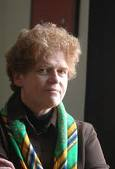
Ransdell, however, is no novice to this kind of activity. He told me that he has crashed holocaust speaking engagements in the past, including Deborah Lipstadt at Xavier in March 2007, and has had some success for his efforts. Because it was a smaller audience than Wiesel’s will be, Ransdell was able to interrupt Lipstadt’s speech when she started talking about the Holocaust. He asked, “Now which Holocaust are we talking about here, the first or the second?” As the room fell silent, he continued, “are we talking about the one in 1919, when Ilya Ehrenburg claimed that 6 million Jews were being killed in a Holocaust … or the second one?” Lipstadt fumbled for a second and Ransdell rose and said even more before he was ordered to leave. But he continued talking on the way out, and Lipstadt had no answer.
He is not planning to attend the “Evening with Elie Wiesel” himself, but hopes to inspire some action by others with the promise of the $1000 reward. We will report on further developments next week. You can contact Robert Ransdell at [email protected]. He could probably use some financial contributions to help cover his costs, if you feel inclined.
* * *
UPDATE: May 2, 6:15 p.m.
From the Cleveland Jewish News: For the ADL, this is another sign of rising antisemitism.
Hate Fliers target Wiesel’s May speech in Cincinnati
MARILYN H. KARFELD
Senior Staff Reporter |
Anti-Semitic fliers have been posted at the University of Cincinnati and nearby Xavier University, targeting Elie Wiesel, a Nobel Peace Prize laureate and Holocaust survivor, who is speaking at Xavier on Sunday, May 6.
On April 4, about 30 fliers were posted at the University of Cincinnati on and around the Hillel Jewish Student Center, and a couple were found by the student union, said Judith Wertheim, 20, a resident of University Heights and a junior at the university. The fliers were posted a day after Hillel began advertising Wiesel’s speech, which is being presented by The Center for Holocaust and Humanity Education, an independent nonprofit in Cincinnati.
The fliers, which call Wiesel a liar and a fraud, among other scurrilous charges, [No mention of the legitimate question of Where Is Elie’s Tattoo? That is not hate, and it is very dishonest of them to not state the actual contents of the flyer. They are AFRAID of the tattoo question. -cy] were also spotted on the campus at Xavier University, a Jesuit institution that is co-sponsoring his appearance.
In response, the University of Cincinnati’s Undergraduate Student Senate passed a resolution supporting a letter drafted by Rabbi Elana Dellal, executive director of its Hillel, and submitted to the senate by Stephen Lamb, a student intern at Hillel. The letter criticized the fliers’ message, said Wertheim, a senator from the College of Allied Health Sciences.
“We, the student body of the University of Cincinnati, will not stand by as intolerance occurs on our campus,” Dellal wrote in the letter titled “We Will Not Be Silent.”
“We, students and supporters of the University of Cincinnati, understand that denying that the Holocaust happened is anti-Semitic,” the letter continued. [Did the flyer deny the holocaust happened? -cy] “There is no place on our campus for intolerance of any kind, be it religion, race, gender, sexual orientation or ethnicity.”
Jewish students active at Hillel, who plan to attend Wiesel’s speech, also decided that doing more than writing the letter and alerting the student government to the fliers was “giving too much power to this person posting them,” said Wertheim. “This wasn’t a threat of violence. But we don’t condone hate speech [only their own -cy], which is why we brought it to the student government to get more backing.”
When informed of the fliers, university officials said they would “keep an eye out,” said Wertheim. “It was very clear the university is very supportive of Hillel.”
The Center for Holocaust and Humanity Education is presenting Wiesel, a Romanian-born Holocaust survivor and author, with financial support from the Jewish Foundation of Cincinnati. Wiesel’s first book “Night,” the 1956 memoir of his experiences in Nazi concentration camps including Auschwitz, has sold millions of copies. [Why does the author of a 10- million-plus-selling-book need financial support? And 1956 is not the publication date for Night, but for the Yiddish book Un di velt hot geshvign … the one Elie never talked about until Nikolaus Grüner brought it to public attention after the 1986 Nobel Prize awards. -cy]
The author of the flier identifies himself as Robert Ransdell, coordinator of Cincinnati’s unit of the National Alliance, a white supremacist group that has dwindled in support in recent years and only has about a dozen active participants, said David Schneider, an Anti-Defamation League investigative researcher based in Chicago.
“Elie Wiesel, because of his prominence and his status, attracts the attention of Holocaust deniers and white supremacists,” said Schneider.
Wiesel has not spoken in Cincinnati in a decade, said Sarah Weiss, executive director of The Center for Holocaust and Humanity Education. Many schools in the area include “Night” in their reading lists, and there are already 4,000 reservations for the event, including 2,000 students, she said.
“While it is unfortunate that individuals who hate and want to deny history are present and visible and active, it’s a small minority of people,” said Weiss. “We should use this to energize and galvanize efforts around Holocaust education. Maybe, in a small way, it’s an opportunity for us.”
Publicizing hate-mongering activities requires walking a fine line, said Nina Sundell, area director of the Anti-Defamation League, whose region covers Ohio, Kentucky, West Virginia and western Pennsylvania.
“The purpose of distributing the fliers is to bring more attention to a hateful activity,” she said. “There’s a downside to publicizing that as more people hear their message. However, one of the best ways to fight hateful rhetoric and speech is through other speech, the reverse type. It’s always a judgment call” whether or not to make these activities public.
Sundell has not decided if she should become involved in the Cincinnati incident. “Would it assist them in putting forth a positive message or spread the hateful message further?” she asked. “We feel it is the ADL’s role to bring these issues to light, but we need to examine this situation further to decide if we take any action.”
[email protected]
The lesson here, dear readers, is that even the smallest of actions against St. Elie of Wiesel will bring down a torrent of abusive reaction from the guardians of the most powerful narrative in the Jewish arsenal.
8 Comments
Category Featured | Tags: Tags: $1000 Elie Wiesel Tattoo Challenge, Center for Holocause and Humanity, Elie Wiesel, Holocaust fraud, Robert Ransdell, Xavier University,
Social Networks: Facebook, Twitter, Google Bookmarks, del.icio.us, StumbleUpon, Digg, Reddit, Posterous.
Wednesday, March 7th, 2012
By Carolyn Yeager
copyright 2012 Carolyn Yeager
Elie Wiesel questioned under oath in a California courtroom in 2008:
Q. And is this book Night that you wrote a true account of your experience during World War II?
A. It is a true account. Every word in it is true.
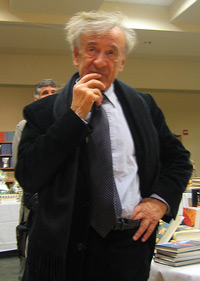
Elie Wiesel manning his table at a Jewish book fair in Austin, TX, 2006. The new translation of Night by his wife Marion had come out in January of that year, and it was immediately chosen for Oprah Winfrey’s book club.
In Part One, I established that the decision to rebrand Night into an autobiography was the reason for a new translation, in which necessary changes could be made to better ‘fit’ the story both to the real Elie Wiesel and the known facts of the Hungarian deportation.
When the 2006 translation came out, with its new classification to “autobiography,” questions arose from some circles. Responding to these questions, Edward Wyatt wrote an article in the NewYork Times on Jan. 19, 2006, in which he quoted Jeff Seroy, senior vice president at Farrar, Straus & Giroux, parent company of Night publisher Hill & Wang, as strongly denying that changes were made to bring the book more in line with the facts. “Nonsense,” said Seroy. “Some minor mistakes crept into the original translation that were expunged in the new translation. But the book stands as a record of fact.”
Blaming the Translator
“Mistakes in the original translation” can only mean mistakes by Stella Rodway, the original translator! But we have already shown that Stella Rodway faithfully reproduced the French La Nuit, which was Wiesel’s own work. The author and publisher are casting these changes as translation errors to divert attention away from Elie Wiesel’s own errors—part of their campaign to pass Night off from now on as “a record of fact.”
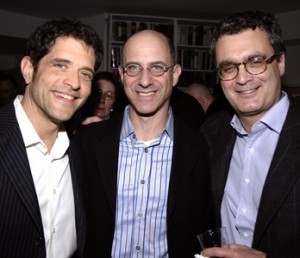
Publisher Jeff Seroy, center, with writer Brad Gooch to his left, Doug Stumps on his right .
A record of fact it isn’t
When I ended Part One, Eliezer and Father were still in the train car on their way to Buchenwald. You will recall that the Yiddish, the French and thus the original English version of Night specified the trip took 10 days and 10 nights from Gleiwitz (on the former German/Polish border) to Buchenwald. Since we know from standard historical sources1 that the prisoners were evacuated from Monowitz on Jan. 18 and arrived in Gleiwitz the next day, Jan. 19; and since according to the description in Night itself, they spend three days in Gleiwitz (Jan. 20-22), this would make their day of arrival February 1, 1945. But in Night, Father’s death takes place the night of Jan. 28-29, three days before they arrived! This is why Marion Wiesel removed the number 10 in her new translation, leaving the number of days and nights undetermined.
A strange detail that actually belongs in Part One is on page 87 of the original Night. Eliezer remarks, after his and his Father’s deliberations and final decision to go on the march: “I learned after the war the fate of those who had stayed behind in the hospital. They were quite simply liberated by the Russians two days after the evacuation.” The evacuation, as we all know, was on the 18th. We also know the Russians did not arrive on the 20th of January! The actual liberation day is January 27. What possessed Wiesel to write this? Well, because it was in Un di velt: “Two days after we had left Buna, the Red Army occupied the camp. All the sick had stayed alive.”
From the point in the story of Eliezer and Father’s arrival at Buchenwald there are no significant changes made by Marion Wiesel to the original French and English versions. But there is much in all the versions that differs strikingly from the “official holocaust history” as written by acknowledged official chroniclers such as Danuta Czech. So I will continue with comparisons between Night and “official history,” along with some very significant changes made from Un di velt hot geshvign to Wiesel’s edited French La Nuit.
Arrival at Buchenwald: 26 Jan. or 1 Feb.?
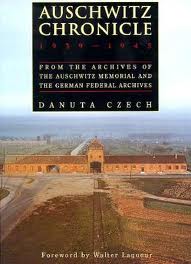 Danuta Czech, in her Auschwitz Chronicle1, records that on January 26,
Danuta Czech, in her Auschwitz Chronicle1, records that on January 26,
A transport with 3,987 prisoners from Auschwitz auxiliary camps reaches Buchenwald. There are 52 dead prisoners in the transport. 115 prisoners die on the day of arrival. Their corpses are delivered to the autopsy room. (P 801)
This is the transport that carried Lazar and Abraham Wiesel/Viezel, Miklos (Nikolaus) Grüner and all of the inmates of Monowitz whose names are on the transport list.2 According to Czech, the Monowitz prisoners began their march on the evening of January 18, 1945, with “divisions of nurses placed between the columns” of 1000 each (P 786), arriving at Gleiwitz Camp the following evening. On Jan. 21 “they are loaded in open freight cars with other prisoners from Auschwitz who have arrived in Gleiwitz.” (P 788) From Jan. 21 to Jan. 26 is five days of travel … not ten, as Wiesel wrote in Night.
The narrative in Night gives us a date of Jan. 22 for the boarding of the train, one day later than Czech. And while Night gives the number of days on the train (10), it does not name the date of arrival.
Hilda Wiesel says her father died on arrival
Totally contradicting what is written in Night, Hilda Wiesel Kudler, Elie’s oldest sister, in her testimony for the Shoah Foundation in 1995, said she learned from her brother that their father died as he stepped off the train.
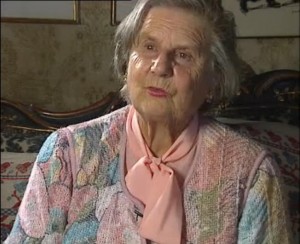
Hilda Wiesel Kudler, in France, giving her videotaped testimony to the Shoah Foundation
And I said, where is father? And he replied, he’s gone back to Sighet; he[Elie] didn’t want to tell me [that he was dead]. And I repeated, but where is he? And he insisted he was at Sighet. And I said, look, I want you to tell me the truth. Because he knew the date of my father’s death. You know, they did a long march3 from Auschwitz, then they put them on the train to go to Buchenwald; he died gasping for air; when he stepped off the train, he died gasping for air; at Buchenwald. But he[Elie] knew the date.
From this, we can better understand something about Elie Wiesel—that he has never had a problem with making up stories that “sound better” than the truth. But, if Hilda is correct in her recall, and if their father really was one of the 115 inmates who Danuta Czech reports died on the day of arrival, then Wiesel’s long, melodramatic story of watching his father sicken and die over a ten-day period in Night is fiction. All of it—including his father being whacked on the head by a cruel “officer” in the barracks.
The day of arrival for this transport is Jan. 26, but according to the timeline in Night, it arrives on Feb. 1. Either way, it doesn’t correspond to the date of Jan. 28 that Wiesel, for reasons unknown, selected as the date his fictional Father died.
You might also be interested to know that Hilda is named Deborah in Un di velt; the name Hilda is never used. It was Wiesel who changed it to Hilda in La Nuit.
Un di Velt says Father dies a week after arrival in Buchenwald, Night says 8-10 days … yet it is January 28 … or is it the 18th Day of Shevat?
Regular readers of this blog will know this already, but it bears repeating yet again: there is no Shlomo Wiesel in the official history or in the records who fits the profile of “Father” as described by Elie Wiesel in Night. There is an Abraham (sometimes shortened to Abram) Viezel who is recorded in several places—on a medical report at Auschwitz, on the transport to Buchenwald, and on a death certificate dated Feb. 2, 1945, seven (7) days after arrival. This Abraham was born Oct. 10, 1900, making him 44 years old when he died. Recall that Night gives Father’s age as 50 in 1944 (SR, P 40).
Wiesel’s description has the transport to Buchenwald arriving on Feb.1st. But that’s just the beginning. After arriving, this is the timeline given in both the original Night and Marion Wiesel’s 2006 translation:
It was daytime when I awoke. I went to look for my father. (Feb. 2nd)
[…]
On the third day after our arrival at Buchenwald, everyone had to go to the showers [his father went too-cy]. Even the sick who had to go through last. (Feb 4th) […] Struck down by dysentery, my father lay in his bunk, five other invalids with him. I sat by his side watching him … A week went by like this. (Feb. 11th or Feb. 8th depending on how you read it)
[ . . . ]
When I got down after roll call, I could see his lips trembling as he murmured something. […] Then I had to go to bed. I climbed into my bunk, above my father, who was still alive. It was January 28, 1945. (still Feb. 8 or 11) I awoke on January 29 at dawn. In my father’s place lay another invalid. They must have taken him away before dawn and carried him to the crematory.” (Feb 12th or 9th) [Stella Rodway translation, pp 107-112]
The timeline in Un di velt is not in doubt:
On the seventh or eighth day of our being in Buchenwald, the bunk-elder [should be block-elder -cy) who used to deal out bread for the whole bunk [sic], came to me. . . .
[ . . . ]
On the same day, in the evening, disaster struck. The end. During roll call. The healthy had to go out of the block in order to be counted by the S.S. men. The sick stayed in their bunks. My father and I thus stayed inside. He — because of his dysentery and I — because of my bandaged foot. Father was lying in the lowest bunk and I — in the uppermost.
[ . . . ]
After roll call, I immediately jumped down from the uppermost bunk and ran to him. He was still breathing. But — he was silent.
[ . . . ]
For a couple of hours I stayed by him and looked at his face long and well […] Then they forced me to go lie down to sleep. I climbed up to the uppermost bunk and I did not know that in the morning, on awakening, I would find my father no more.
It was the eighteenth of Shevat, 5705.
* * *
Nineteenth of Shevat. Early in the morning.
I got up and ran to my father. Another sick man was lying in his place.
I had a father no more. (pp 233-238)
Readers might be surprised to learn that the Hebrew calendar date of 18-19 Shevat, 5705 corresponds to February 1-2, 1945! How neat is that? So, in Un di velt Father dies seven days after arrival, on the very same day as Abraham Viezel died, who was officially recorded at Buchenwald with the registration number of 123488 and the Auschwitz registration number of A-7712. (However, Un di velt also says that the trip from Gleiwitz to Buchenwald took ten days, which means they could not have arrived until sometime in February. Seven days from that time would not be Feb. 2nd.)
So can we conclude from this that Abraham is Shlomo? Not necessarily. The Yiddish author reports Father’s death as occurring during the night of 18-19 Shevat (Feb. 1-2), but Elie Wiesel, author of La Nuit, says the date is Jan. 28th! Why? Who can answer that but Elie Wiesel? He certainly knows what the month of Shevat and the year 5705 means … or he could have easily found out.
Or can we conclude that Un di velt was written by Lazar Wiesel, as Nikolaus Grüner claims … that he wrote his story as a father-son relationship … and that he was perhaps not the brother of Abraham as Grüner says he was? (It’s noted on Lazar’s Buchenwald file card that his father was also in Buchenwald; his mother in Auschwitz.) Well, again, not necessarily. There are other possibilities. But I’m getting ahead of myself.
The facts are, there are problems with all of these theories; none is a perfect fit. We can ask: If Elie Wiesel is the author of Un di velt hot geshvign, why did he change so many of the underpinning facts of the story when he rewrote it in French as La Nuit? This is a real head-scratcher. We can also ask: Why did Naomi Seidman, the Jewish professor who discussed in detail some of the differences between the Yiddish book and Night, not mention the 18th of Shevat? Is it because she couldn’t find an explanation for it? Siedman, Ruth Franklin and other Jewish reviewers have never brought up some of these Yiddish to French discrepancies. They are too embarrassing a problem for them.
What we can safely say is that no matter who the author of Un di velt was … he was totally unfamiliar with the real facts of when the Monowitz prisoners arrived at Buchenwald. Was it because he was not one of them? Was it because he was not concerned about accuracy since his story was directed at a non-critical audience—a Yiddish-speaking Jewish audience? As we continue, we’ll find more mystifications, but also a few certainties.
What happens to Eliezer after Father’s death?
Wiesel writes in Night (essentially the same in all translations):
I had to stay at Buchenwald until April eleventh. I have nothing to say of my life during this period. […] I was transferred to the children’s block, where there were six hundred of us. […] I spent my days in a state of total idleness. And I had one desire—to eat. I no longer thought of my father or of my mother. (SR, P 114)
He continues that on April 10, a general evacuation of the remainder of the camp—20,000 prisoners in all, including “several hundred children”—was begun but was soon interrupted. It resumed on the 11th but was again interrupted around ten a.m. when the camp inmate “resistance movement” rose up, firing guns. And then at 6 p.m. on that same day the first American tank arrived. This corresponds pretty well with the official story, but then it goes astray.
In a November 2000 interview with Oprah Winfrey, Wiesel recalled:
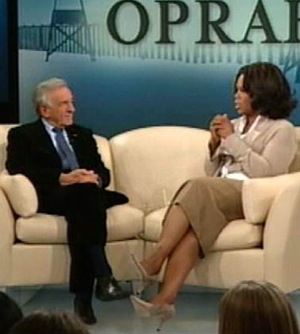
Elie interviewed by Oprah in 2000.
… and we [children] were left until the end. But every day we marched to the gate anyway. I was near the gate more than five times before I was released, and each time, the gate closed just before I came to it.
Ah, we have heard this before, haven’t we? As exaggerated as it sounds, in Un di velt the author goes even further. He writes:
I didn’t even bother to try hiding myself. Let myself be born along with the stream. Tens of times I stood before the iron camp gate, on the threshold of death, and always something happened which brought us back to the block.
Un di velt continues: “If I was not killed then it is merely thanks to almightly chance. For – because of the hunger, I even wanted to go to the gate: outside the gate, they were distributing bread and marmalade.”
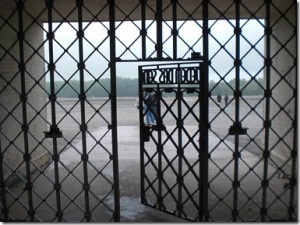
The front gate at Buchenwald, from the inside looking out, that Wiesel says he marched right up to “tens of times” but was always turned back!
- Liberation brings Freedom and Revenge
UdV, P 244: The first gesture of freedom: the starved men made an effort to get something to eat. They only thought about food. Not about revenge. Not about their parents. Only about bread. And even when they had satisfied their hunger—they still did not think about revenge.
SR, P 115: Our first act as free men was to throw ourselves onto the provisions. We thought only of that. Not of revenge, not of our families. Nothing but bread.
Oprah Winfrey interview: Oprah asks, “After you were liberated, what did you do?” Wiesel answers: “The first thing many of us did was reassemble to say a prayer for the dead.” (page 5)
* * * *
UdV, P 244: Early the next day Jewish boys ran off to Weimar to steal clothing and potatoes. And to rape German girls [un tsu fargvaldikn daytshe shikses]. The historical commandment of revenge was not fulfilled.
LN, P 178: Le lendemain, quelques jeunes gens coururent à Weimar ramasser des pommes de terre et des habits—et coucher avec des filles. Mais de vengeance, pas trace.
SR, P 116: On the following day, some of the young men went to Weimar to get some potatoes and clothes—and to sleep with girls. But of revenge, not a sign.
MW, P115: The next day a few of the young men ran into Weimar to bring back some potatoes and clothes—and to sleep with girls. But still no trace of revenge.
In this case, Wiesel made the change from ‘rape’ to ‘sleep with’ in La Nuit. The expression for “German girls” that we find in the Yiddish book was also removed. The term that was actually used is shikses, a word which originally meant “abomination” and which is used today as a term of contempt for all non-Jewish women. In other words, in saying daytshe shikses, the author was expressing, in rather vulgar terms, his contempt and hatred for German women. This apparently was not good for the eyes of the Goyim to see. It was changed by Wiesel in the French La Nuit, and thus it never reached our eyes until now.
Yet, the Yiddish author goes even further and decries the failure of the Jewish males to take a proper revenge, which is here envisioned as a much larger public act of retribution than the “too mild” raping of German women. (Public retribution, of course, did come later with the Nuremberg Military Tribunals.)
Eliezer is hospitalized for two weeks—April 14 to April 28
UdV P 244: Three days after liberation I became very ill; food-poisoning. They took me to the hospital and the doctors said that I was gone. For two weeks I lay in the hospital between life and death. My situation grew worse from day to day.
SR P 116: Three days after the liberation I became very ill with food poisoning. I was transferred to the hospital and spent two weeks between life and death.
MW P 115: Three days after the liberation of Buchenwald, I became very ill: some form of poisoning. I was transferred to a hospital and spent two weeks between life and death.
Three days after liberation on April 11th is April 14th. Thus, Eliezer is in the hospital from April 14 until April 28—extremely ill, close to death. In his 1995 memoir, All Rivers Run to the Sea, Elie Wiesel claims that on that day (the 14th) he was thrown a can of lard, which he apparently ate although he doesn’t remember doing so. He lost consciousness and awoke in a hospital. But the addition of this story, which is in the original Un di velt, presents serious problems for Elie Wiesel. Perhaps the hospital story had slipped his mind when he decided to claim he was one of the survivors lying on a bunk in the “famous Buchenwald liberation photograph.” Because he was in the hospital …
He cannot be in the famous Buchenwald liberation photo taken on April 16 …
I have already demolished the false claim that Wiesel is in that photograph here. But on top of that, our translator found an interview of Leo Eitinger, a Jewish Czech-born psychiatrist, by Harry James Cargas, a friend and biographer of Elie Wiesel, which contained this gem:
HJC: The same thing happened with Livia Rothkirchen at Yad Vashem as happened with you. I was there doing research on atrocity photography for my book A Christian Response to the Holocaust and saw a photo that covers a large wall, of seventeen men lying in their bunks at liberation time. I think you’ve probably seen this picture. Wiesel and Dr. Rothkirchen passed it by many times, over a several-year period, before he told her he was in that photograph. I asked Elie if I could write something about it and he said, “No.” I wrote something and showed it to him and he gave me permission to publish it.
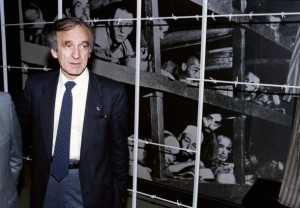
The photo at Yad Vashem in Israel with Elie Wiesel posing in front of it in 1986 after receiving the Nobel Peace Prize in Oslo.
LE: I didn’t know Elie is in the photo.4
Cargas’ book was published in 1993, ten years after it was publicly announced that Elie Wiesel was in that photograph. Apart from the revelation that Cargas has to ask permission from Wiesel before he publishes anything about him, can you imagine that after walking by that famous photo for several years, Wiesel would finally think to say, “Oh hey, that’s me laying there, back in the shadows.”
He cannot have been present to agree to and sign the Military Questionaire on April 22 …
Much has been made by holocaust historians like Kenneth Waltzer and others I won’t name that this Fragebogen made out for Lázár Wiesel proves that Elie Wiesel was in Buchenwald. The birth date is not Elie’s; the date of arrest is not Elie’s; the signature is not Elie’s; the registration number belongs to another prisoner (Pavel Kun) who died only a month earlier; and on top of all that … Elie himself tells us in Night that he was lingering between life and death in the hospital on April 22. He was still six days away from having recovered enough to leave the hospital.
He cannot be in the photograph of the “Boys of Buchenwald” taken on April 27.
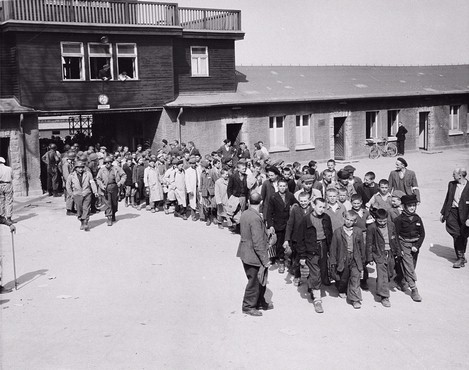 Kenneth Waltzer also claims on his Michigan State University website that Elie Wiesel is “seen to the left” (short boy fourth from the front in left row wearing dark suit in front of the taller boy wearing a beret) in this photograph of the youths being transferred from the barracks inside Buchenwald to the former SS barracks on the outside. Why is Waltzer not paying attention to what is written in Night — that Eliezer was put in the hospital on the 14th of April, at death’s door, and remained for two weeks? One really has to wonder at the stupidity of holocaust historians. Or more likely — how stupid they think the rest of us are! See The Many Faces of Elie Wiesel.
Kenneth Waltzer also claims on his Michigan State University website that Elie Wiesel is “seen to the left” (short boy fourth from the front in left row wearing dark suit in front of the taller boy wearing a beret) in this photograph of the youths being transferred from the barracks inside Buchenwald to the former SS barracks on the outside. Why is Waltzer not paying attention to what is written in Night — that Eliezer was put in the hospital on the 14th of April, at death’s door, and remained for two weeks? One really has to wonder at the stupidity of holocaust historians. Or more likely — how stupid they think the rest of us are! See The Many Faces of Elie Wiesel.
The book’s ending: What does the long passage in Un di velt hot geshvign tell us?
UdV P 245: One fine day I got up—with the last of my energy—and went over to the mirror that was hanging on the wall. I wanted to see myself. I had not seen myself since the ghetto.
From the mirror a skeleton gazed out.
Skin and bones.
I saw the image of myself after my death. It was at that instant that the will to live was awakened.
Without knowing why, I raised a balled-up fist and smashed the mirror, breaking the image that lived within it.
And then—I fainted.
From that moment on my health began to improve.
I stayed in bed for a few more days, in the course of which I wrote the outline of the book you are holding in your hand, dear reader.
But—
Now, ten years after Buchenwald, I see that the world is forgetting. Germany is a sovereign state, the German army has been reborn. The bestial sadist of Buchenwald, Ilsa Koch, is happily raising her children. War criminals stroll in the streets of Hamburg and Munich. The past has been erased. Forgotten.
Germans and antisemites persuade the world that the story of the six million Jewish martyrs is a fantasy, and the naive world will probably believe them, if not today, then tomorrow or the next day.
So I thought it would be a good idea to publish a book based on the notes I wrote in Buchenwald.
I am not so naive to believe that this book will change history or shake people’s beliefs. Books no longer have the power they once had. Those who were silent yesterday will also be silent tomorrow. I often ask myself, now, ten years after Buchenwald:
Was it worth breaking that mirror? Was it worth it?
SR P 116: One day I was able to get up, after gathering all my strength. I wanted to see myself in the mirror hanging on the opposite wall. I had not seen myself since the ghetto.
From the depths of the mirror, a corpse gazed back at me.
The look in his eyes, as they stared into mine, has never left me.
MW P 115: One day when I was able to get up, I decided to look at myself in the mirror on the opposite wall. I had not seen myself since the ghetto.
From the depths of the mirror, a corpse was contemplating me.
The look in his eyes as he as he gazed at me has never left me.
The difference in length between the Yiddish and the English passage is the first thing that strikes us. The Yiddish writer had a lot to say in these final thoughts. He regained his “will to live” right there in the hospital. Twice he speaks of writing an outline and notes for Un di velt hot geshvign while still in his hospital bed. But there is no record by Elie Wiesel anywhere that says he did any writing in preparation for writing his “testimony” while in the camp (in fact, just the opposite), or at any time in advance of 1954.
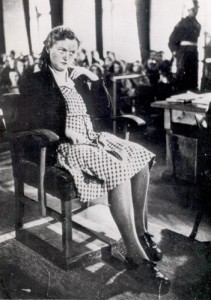
Ilse Koch on the witness stand in 1947. She was seven months pregnant and the only woman brought before the American Military Tribunals held at Dachau.
The tragic true story of Ilse Koch is that she gave birth to one child while a prisoner of the Americans but she certainly was not allowed to raise him. She was hounded, vilified and persecuted after the war, retried by a German court in 1951 after being acquitted at the IMT, and ultimately given a life sentence—solely, it can be argued, to satisfy Jewish vengeance. She committed suicide in prison in 1967.
The Yiddish author also mentions the “six million Jewish martyrs” … in 1954. This number emerged from the Nuremberg Tribunals, but we know that claims of “six million Jewish victims” goes all the way back to the 1890’s.
All this and more was cut out for the French La Nuit (which, remember, was written by Wiesel) and the English versions which were taken from the French. As has been noted by Jewish commentators themselves, the Yiddish writer is an angry, politically-minded religious Jew who expected, or wished, the world to have been transformed by the travail of the Jews during WWII. He is bitterly disappointed. There is more in this final chapter of the Yiddish book that doesn’t appear in the French or English versions. Here is just one passage:
Dreams of truth, of freedom are false dreams for men. Visions of justice and equality are false visions for men. Man is: the struggle for bread, for meat; man is: the struggle to satisfy one’s own instincts.
Man is instinct to the core. Flesh to the core. And not heart. And not spirit. And not morality.
I learned that in Buchenwald. And what one learns in such conditions is without a doubt the truth, the purest truth. For man can really know man only in extreme conditions, when he has thrown away from himself all masks, social and psychological, and appears before us naked, as he is in truth.
In Buchenwald I saw the true face of man. The face of a human animal, which is worse than a true animal. O God, woe is you, woe is man, how trifling and puny. Ought you to even exist, if the son of Adam was made in your image!
God . . . I had ceased to believe in his existence. But despite that, I continued to believe in his evil. (UdV, P 240-41)
Was this written by Elie Wiesel? If it was, he is a man who has put on his own mask to play the game of Jewish vengeance against the goyim persecutors of his people. In other parts of Night, Wiesel writes of losing his faith in a caring God, of no longer following his religion—but later he denied that is true, even though he wrote it! But this passage in Un di velt is too passionate to dismiss as merely a passing sense of discouragement. That is, of course, unless it is just a literary construct and doesn’t reflect any truth of the author.
What does it all mean?
The title of this two-part article is “What Changes were made to Elie Wiesel’s Night, and Why.” I didn’t promise to solve the mystery of the author of Un di velt hot geshvign, but I did hope I might do so, or at least eliminate some contenders.
I confess I expected there to be more difference between the Yiddish and the French books than it turns out to be. It is now clear that La Nuit was taken directly from Un di velt, although that doesn’t mean they were written by the same person. However, that is the greater likelihood unless it can be proven otherwise. Similarly, if Elie Wiesel is the author of Un di velt, it doesn’t mean he was in the camps. The fact that the books are filled with errors argues against it.
Night is a novel
It’s difficult to come to any certainties when the material we have to work with is so internally inconsistent and when there are several versions of it—similar in some ways to the many versions of the Anne Frank Diary. But we can conclude for certain that Night only works as a novel, not as an autobiography—no matter how much the Jewish spin doctors say that a memoir, to be a work of “great literature,” must include some fictional flights of fancy. Nowhere does Night fit the facts. Even with wife Marion’s changes in 2006, it couldn’t be pulled together enough to make a convincing true-life testimony. And we know how many of these “survivor novels” there are around. It’s not like many other hopefuls didn’t have the same idea!
The Lazar-Lázár Riddle
In spite of all the above, I would like to propose a hypothetical scenario, one that I am not endorsing, for obvious reasons, but that does have the value of answering one of the more ignored aspects of this riddle, namely the way the 32-year-old Lazar Wiesel disappeared at the same time the 16-year-old Lázár Wiesel appeared. This cannot be denied. Thirty-one-year-old Lazar arrived at Buchenwald in January; sixteen-year-old Lázár left there in July. The easiest explanation for this is that Lazar wanted to have the papers of a 16-year-old Buchenwald orphan so he could be sent to France. In the confusion of the last months of the war and the immediate post-war period, this kind of thing became more possible. Such an explanation may sound a little far-fetched, but is it any harder to swallow than Elie Wiesel not having the tattoo (Auschwitz ID number) that he says he has? Or Elie Wiesel not having his own Buchenwald identification number, but “borrowing” a dead man’s (Pavel Kun, 2 years older than Elie) right before, or after, liberation? These things don’t make sense. Nor does the fact that in La Nuit Elie Wiesel wrote that his father died on Jan. 28, 1945, while in the Yiddish book that he also claims to have written as his own “testimony” the date is Feb. 2nd? Or that he wrote that the Russian Army took over the Auschwitz complex two days after its evacuation, which everyone knows is false?
Elie Wiesel even wrote in Night that his foot was operated on right before the evacuation of Auschwitz, while in his later real memoir, All Rivers Run to the Sea (pp 89-90), he flat-out recalled it as his knee, something that could not be mis-remembered. I could list many of these senseless “mistakes,” many of which I have written about in earlier articles.
There is something that doesn’t fit well into this Lazar-Lázár hypothesis, though—that is, that we have pictures of the real Elie Wiesel in France at the Jewish welfare orphanage, OSE. But how did he get through a year at Auschwitz and Buchenwald with no records of his being there … and a poor memory of what occurred and when? Did he somehow manage to attach himself to the Buchenwald transport with the stolen identity papers? But also, there are other ways he could have come to be at the Ecouis homes in France than in the children’s transport from Buchenwald. Just as there are other ways he could have come into possession of the Yiddish Un di velt without writing it himself.
Was Elie Wiesel in the camps?
My answer is still no. Wiesel could have been in some camps in some capacity under some auspices, but he is not telling the truth about what camp experience he did have. That means Hilda Wiesel Kudler is also not telling the truth but is standing by her brother. She says at the end of her bitter testimony to the Shoah Foundation, “I will not forget, and I will not forgive.” Have you ever wondered why Elie has not contributed a videotaped testimony to the Spielberg/USC Shoah Foundation library?
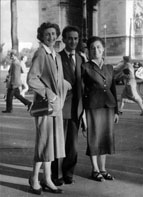
Elie Wiesel with his older sisters Bea (left) and Hilda (right) in Paris after the war, exact date unknown.
Wiesel’s other sister, who changed her name to Beatrice from Batia, never wrote or testified a word about it. She did go to work for Jewish organizations in Germany, however, immediately after the war, helping Jews to emigrate to wherever they wanted to go, including Palestine. The whole family were committed Zionists, as were most Eastern European/Russian Jews who were able to flood into the West because of the war. ‘Bea’ finally got her own papers to emigrate to Canada.
A Jewish organization, Sharit Ha-Platah, gathered names of Jews who were liberated from Dachau and it’s many sub-camps and published them in 1946. This is the only record so far found with the names of Hilda and Beatrice Wiesel, and it is a self-identified list of Jews by Jews, not an official German record of forced laborers or prisoners. So the hard evidence for the Wiesel family is not there. It doesn’t mean they weren’t, however; it’s just that we’re left with believing what they say, because we want to or because we’re expected to.
The easiest option is to go along with Elie Wiesel’s story that he was in those camps, and question his credibility from other angles, such as the in-credible stories he tells. This is what revisionists had done before Nikolaus Grüner came along and released documents he had obtained from Buchenwald and the correspondence he had with the archivists there. These documents cannot be ignored, in spite of what other nonsense Grüner writes in his book Stolen Identity. These documents have caused a sea change in revisionism about Elie Wiesel, to the extent that it can be divided between pre-Grüner and post-Grüner research and writing.
Wiesel needs to expose himself to questions
Because of these documents, it is up to Elie Wiesel to come forth and answer questions about them. But being that he is completely unprepared to do so, this job has been given to his surrogates—Professor Waltzer for one. Kenneth Waltzer promised, with a lot of bombast, that he would produce proof that Elie is Lazar and that Shlomo is Abraham, but for a year now he has failed to produce it, or even say anything more about it. He has also failed to come out with his promised book, “The Rescue of Children and Youths at Buchenwald,” which was to include Elie Wiesel. In the opinion of this writer, Waltzer is as big a fraud as Wiesel, selling emotion and sentimentality instead of factual history. They are both supported with professorships at well-funded universities.
So, back to the main question: Was Elie Wiesel in Auschwitz and Buchenwald? As I said, my answer is still no … and no one should accept that he was without some further explanation from him, during which he subjects himself to questions. If he’s genuine, he can certainly withstand questions. That, however, is not going to happen because … fill in your own answer.
Elie Wiesel has kept the details of his life before 1955 vague. He has managed to prevent unwanted questions from being asked of him. He hides behind a stated aversion to “holocaust deniers” so that anyone who is not a 100% believer is not welcome in his company. He gets away with the ‘moral outrage’ he professes toward anyone who doubts, thus no interviewer, reporter, writer, academic, student or even President dares to doubt in his presence. It works like a charm.
Endnotes
1. Danuta Czech, Auschwitz Chronicle: 1939-1945. New York: Henry Holt, 1997
2. APMO, D-Bu 3/17, pp. 18-85, 87 (transport list as cited by Czech in Auschwitz Chronicle)
3. Hilda was obviously unaware that the march itself was only 24 hours, probably because she had heard so many false and exaggerated stories about “endless days of marching” that proliferate in survivor stories.
4. Harry James Cargas, ed. Voices from the Holocaust, Lexington: University of Kentucky Press, 1993. pp. 116-22.
7 Comments
Category Featured | Tags: Tags: Auschwitz-Birkenau, Buchenwald, Elie Wiesel, Hilda Wiesel, Holocaust fraud, Miklos Grüner, Night, Shlomo Wiesel, Un di velt holt geshvign,
Social Networks: Facebook, Twitter, Google Bookmarks, del.icio.us, StumbleUpon, Digg, Reddit, Posterous.
Friday, February 17th, 2012
By Carolyn Yeager
copyright 2012 Carolyn Yeager
On Tuesday, January 17, 2006, Amazon.com announced that it was changing the categorization of a new translation of Elie Wiesel’s Night from novel to memoir.
Amazon would also revise the editorial description of the original edition to make clear that they consider the book a memoir, not a novel. “We hope to make these changes as quickly as possible,” said Jani Strand, a spokeswoman for the online retailer. The day before, Oprah Winfrey had announced that Night was her latest book club choice, displacing her previous selection, James Frey’s A Million Little Pieces.
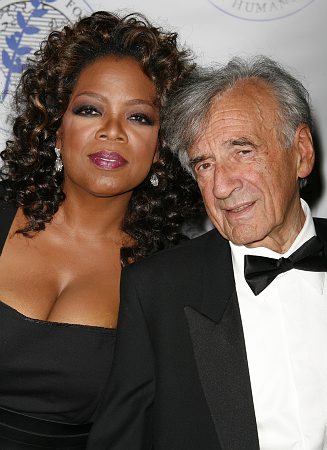 The sudden switch from fiction to non-fiction caused some discussion and questions, which Strand brushed away by saying, “Amazon.com’s data source for the Oprah Book Club edition of Night inaccurately classified the book as fiction.” She declined to offer details. The book, re-classified as “Autobiography” and blessed by Oprah, was already No.3 on Amazon.com as of that Tuesday afternoon! Wiesel, interviewed later with his literary agent Georges Borchardt, insisted they had never portrayed it as a novel.
The sudden switch from fiction to non-fiction caused some discussion and questions, which Strand brushed away by saying, “Amazon.com’s data source for the Oprah Book Club edition of Night inaccurately classified the book as fiction.” She declined to offer details. The book, re-classified as “Autobiography” and blessed by Oprah, was already No.3 on Amazon.com as of that Tuesday afternoon! Wiesel, interviewed later with his literary agent Georges Borchardt, insisted they had never portrayed it as a novel.
But the publisher did.1 There has been confusion about the question for so long—even Wiesel’s defenders have to admit it. Ruth Franklin, in her 2011 book, A Thousand Darknesses, wrote: “Unfortunately, Night is an imperfect ambassador for the infallibility of the memoir, owing to the fact that it has been treated very often as a novel—by journalists, by scholars, and even by its publishers.”2 On Night’s Wikipedia page it has long been described as autobiography, memoir, novel—yes, all three. How long will that continue? As long as there are editions of Night that still sport those labels, one assumes.
Left: Oprah Winfrey and Elie Wiesel pose together at the Elie Wiesel Foundation for Humanity Award Dinner at the Waldorf Astoria Hotel on May 20, 2007. Winfrey was honored with the Humanitarian Award for “positively impacting people all over the world, especially children.” One year earlier, she had selected Wiesel’s “Night” for her popular book club “pick” which sent it immediately to the top of the national bestseller lists.
As for Wiesel and Borchardt, they answered questions about differences in the text of the new edition by saying they were not significant enough to justify raising questions. The next day, Wiesel’s wife Marion, the translator of the new edition of Night, said in an interview that among the changes was a reference to the age of the book’s narrator when he arrives in 1944 at Birkenau, the entry point for Auschwitz.
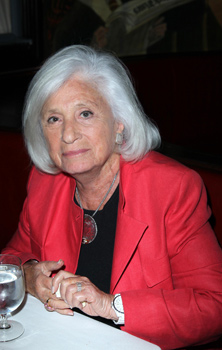 “At no point did this change the meaning and the fact of anything in the book,” Marion Wiesel said. She explained it this way: The narrator tells a fellow prisoner that he is “not quite 15.” But the scene takes place in Spring 1944. Mr. Wiesel, born on Sept. 30, 1928, would have already been 15, going on 16. So in the new edition, she changed it to “15.” Whaaaa? She changed the age of Eliezer as it was written in the Yiddish book to fit Elie Wiesel, who was fifteen and a half at that time. What is written in the Yiddish original, Un di velt hot geshvign, we also find in the original Night, so that can only be called unethical. Marion tried to joke it away, telling reporters “I kidded Elie and told him, ‘I don’t think you can add.'”
“At no point did this change the meaning and the fact of anything in the book,” Marion Wiesel said. She explained it this way: The narrator tells a fellow prisoner that he is “not quite 15.” But the scene takes place in Spring 1944. Mr. Wiesel, born on Sept. 30, 1928, would have already been 15, going on 16. So in the new edition, she changed it to “15.” Whaaaa? She changed the age of Eliezer as it was written in the Yiddish book to fit Elie Wiesel, who was fifteen and a half at that time. What is written in the Yiddish original, Un di velt hot geshvign, we also find in the original Night, so that can only be called unethical. Marion tried to joke it away, telling reporters “I kidded Elie and told him, ‘I don’t think you can add.'”
But that particular change, rather than insignificant, was one of the major reasons that a new translation was undertaken. There are other quite significant changes in the new edition that will be enumerated in this article. When you learn what they are, you can decide for yourself if you think they are insignificant.
Right: Marion Wiesel is the translator of the 2006 edition of Night. Here, in 2010, she attends an after party at The Monkey Bar for Oliver Stone’s new “South of the Border” New York premiere at Cinema 21.
Wiesel wrote a Preface to the New Translation, something he didn’t have in the original La Nuit or Night.
In his preface, Wiesel begins: “Why did I write it? … so as not to go mad or, on the contrary, to go mad in order to understand the nature of madness …”
He continues in this vein—typical Wiesel mystical-religious style. However, in his only description of the writing process of this book—the typing of the 862 pages which he titled Un di velt hot geshvign, according to his later memoir—it is hard to believe that he was in such a state of mind. He writes in All Rivers Run to the Sea that during this time in Paris he is busy with his newspaper job and contacts; also involved in a love affair with a woman named Hanna. He embarks on a major journalistic assignment in Brazil, sent by his editor, taking along a friend to keep him company on the ship’s crossing. They both get free tickets from a “resourceful Israeli friend”—these benefactors are usually unnamed. As the voyage begins, he says his mind is dwelling on Hanna and whether he should take the marriage step that she had asked for.
I can’t imagine an atmosphere less conducive to writing about what he describes as “the immense, terrifying madness that had erupted in history.” But he continues very matter-of-factly in All Rivers, “During the crossing I wrote my testimony …” and in one short paragraph tells us all he thought important to say about it. Moreover, he has never elaborated on it since!
In the new preface, Wiesel writes that in retrospect he doesn’t know what he wanted to achieve with his words, but then he comes up with something: “I knew that I must bear witness. I also knew that, while I had many things to say, I did not have the words to say them.” He needed to “invent a new language.” He is not speaking of an actual language, like German, French or English—but a language of survivors, or for survivors. Wiesel writes that common words like “hunger—thirst—fear—transport—selection—fire—chimney … all have intrinsic meaning, but in those times, they meant something else.” Really? He does not explain how that is so. But Wiesel has tried to create the idea of holocaust survivors as a special class, set apart, who know things others do not know, and can never understand—”Only those who experienced Auschwitz know what it was. Others will never know.”
Wiesel describes his writing as slow! “Writing in my mother tongue (Yiddish) … I would pause at every sentence, and start over and over again. I would conjure up other verbs, other images, other silent cries. It still was not right.” This contrasts totally with his description in his memoir All Rivers Run to the Sea (p. 238-40) that he wrote the original Yiddish manuscript fast and feverishly without re-reading!
Why a new translation of Night after 45 years of success with the old one?
Here again, Wiesel hedges in the preface and doesn’t have a convincing answer. He says his wife Marion has translated other books for him, and “knows his voice better than anyone else.” He says he didn’t pay enough attention to the original English translation by Stella Rodway—after his first reading of Night from the publisher, he never read it again. As for Mrs. Wiesel: “Fluent in French, she had never read the English version,” she said. But good news! Elie Wiesel Cons The World has found a translator and now has large portions of the Yiddish book translated into English. We can compare the real 245-page original to both the 1960 English translation from the French by Stella Rodway and the 2006 English translation done by Marion Wiesel.
In doing so, we have made two important discoveries.
First, Stella Rodway’s 1960 English translation of Night is an accurate rendition of the French text of La Nuit, as originally published in 1958. That means that if there are any “errors” in the Night story, they weren’t put there by Stella Rodway.
Second, when we compare the three texts—the original version of Night, as translated by Rodway, the “corrected” 2006 translation by Marion Wiesel, and the 1955 Yiddish original of Un di velt hot geshvign—we find that the “errors” brought up by Marion Wiesel are for the greater part what was actually written in the original Yiddish book, though usually in more detail there.
In other words, the 1955 Yiddish version, the 1958 French version, and the 1960 English version generally agree—only the “corrected” 2006 translation is different. So, are these really errors of translation that Marion Wiesel is fixing for us? Or are they not simply problems for Elie Wiesel? Under close scrutiny, the Elie Wiesel narrative has huge holes which bring up embarrassing questions, and this is what Marion Wiesel’s new translation was meant to head off.
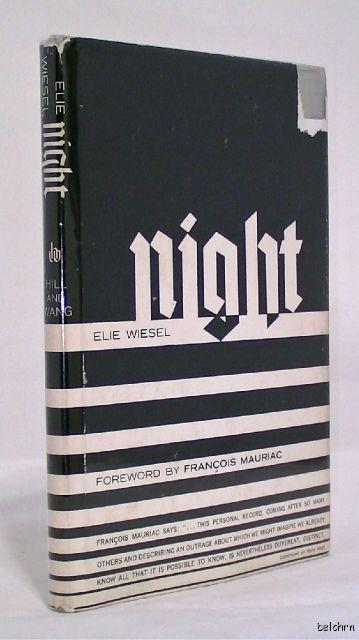
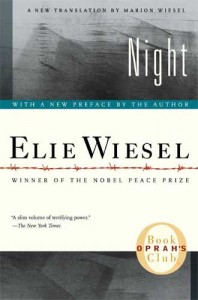
Left: Original Night cover, 1960, features the title, while the author’s name is exceptionally small and insignificant. Francois Mauriac’s forward is featured. In 2006, the author becomes the “title,” i.e. the main selling point, and Mauriac is no longer mentioned, although his forward remains in the book.
A Comparison of the 1960 original with the 2006 new version.
Following are the most “significant” differences I have found between the Stella Rodway 1960 translation and the Marion Wiesel 2006 translation. To make as clear a case as possible, I begin with the Yiddish [UdV] and its French translation La Nuit [LN], followed by the Stella Rodway English translation [SR]. Finally, Marion Wiesel’s revised translation [MW]. The word or phrase being compared is in boldface. Number one has already been written about in When Did Elie Wiesel Arrive at Auschwitz?
1. The Saturday before Pentecost … or two weeks before?
UdV Page 22: Geshen iz dos Shbth far Shbw’wth. A friling-zun hot oysgegosn ir likht un varemkeyt iber der gorer velt un oykh iber geto … / It happened Saturday [Sabbath] before Shavuot. The springtime sun had spread its light and warmth over the whole world, and even over the ghetto. . . .
LN Page 29: Le samedi précédant la Pentecôte, sous un soleil printanier, les gens se promenaient insouciants à travers les rues grouillantes de monde / The Saturday preceding Pentecost …
SR Page 23: On the Saturday before Pentecost, in the Spring sunshine, people strolled carefree and unheeding, through the swarming streets.
MW Page 12: Some two weeks before Shavuot (Pentecost). A sunny spring day, people strolled seemingly carefree through the crowded streets.
The Yiddish, the French and the original English versions agree—it was the Saturday before the festival of Pentecost/Shavuot—but Marion Wiesel’s new edition sets that date back by two whole weeks. This is very significant because, as the story continues, it was later on the following day that the Jews of Sighet were forced to leave their homes in preparation for their eventual deportation: “The ghetto was to be liquidated entirely. We were to leave street by street, starting the following day.”
So Mrs.Wiesel was NOT correcting errors in the English translation, but changing the text to fit the reality of when the Hungarians from Sighet arrived at Birkenau. Pentecost was on Sunday, May 28, 1944. The “Saturday before Pentecost” is thus May 27. Some two weeks before is May 14.
Un di velt hot geshvign, La Nuit and the Rodway translation all have Eliezer’s family leaving on the final journey to Auschwitz around June 2nd, six days after Pentecost/Shavuot, which was a Friday. However, they also agree that “Saturday, the day of rest, was chosen for our expulsion.” So it’s necessary for us to add another day to the family’s stay in the small ghetto to make the chronology work. On Saturday, then, the Jews are marched to the synagogue and spend the night there; in the morning, Sunday June 4, they board the train: “The following morning [Sunday], we marched to the station, where a convoy of cattle wagons was waiting. [… ] We were on our way.” Four days and three nights on the train (according to the description in Night) makes their arrival date June 6, 1944, around midnight.
But this is not only long after the prisoner number A7713—which Elie Wiesel supposedly received at Auschwitz, and still (again, supposedly!) has tattooed on his left arm—had been given out, but also long after the last transport left from Sighet. Indeed, there were no transports from the town after May, according to official records.
Marion Wiesel did not mention this one to the reporters; nor did Elie speak of it in his preface to his wife’s translation. But it was discovered by our translator. Marion Wiesel’s arbitrary “correction” allows Eliezer’s family to leave on May 21 and to arrive by May 24 (just before midnight!) thus making it possible for Eliezer to receive the registration number A7713. This is a very significant change, probably the most significant in her entire new English translation.
An added note: This interesting passage is on page 27 of Un di velt, but is not included in the shorter French or English Night:
We had opportunities and possibilities to hide with regular goyim and with prominent personalities. Many non-Jews from the surrounding villages had begged us, that we would come to them. There were bunkers available for us in villages or in the mountains. But we had cast aside all proposals. Why? Quite simple: the calendar showed April 1944 and we, the Jews of Sighet, still knew nothing about Treblinka, Buchenwald and Auschwitz.
Now we have April as the general time of deportation! So according to the timeline we find in Un di velt, Eliezer and his family left Sighet some time in June, while the calendar on their wall still said April . . . and in the meantime, we know from official Auschwitz records that the deportations actually occurred in the last two weeks of May. The person who wrote this knew nothing about the real deportation dates for the Sighet Jews.
2. Copulating on the train … or just caressing?
UdV Page 47: Tsulib der engshaft hobn a sakh instinktn zikh dervekt in kerper. Erotishe instinktn, un untern forhang fun der nakht hobn yungeleyt un froyen zikh gelozn bahersht durkh di oyfgereytste chwshym zeyere.
Ot der ershter rezultat fun umglik: erotishe freyheyt. Di shpanung fun di letste teg hot itst gezukht a veg vi oystsulodn zikh un der leychtster iz geven – an erotisher.
Di erotishe stsenes hobn nisht dervekt keyn protestn mtsd di eltere Yidn. Zey hobn farmakht oyern un oygn, zikh gemakht nisht zen un nisht hern. In moment fun schnh faln avek di keytn fun der konventsioneler moral. Mentshn hobn zikh getrakht: ver veys vos der morgn iz “lwl tsu brengen? Zol yugnt oysnutsn dem heynt, oystsapn fun im dem letstn hn’h-tropn . . .
In English: Because of the crowding, a host of instincts awoke in [people’s] bodies. Erotic instincts – and beneath the curtain of night young men and women let themselves be ruled by their aroused senses.
And so the first result of misfortune: erotic freedom. The stress of the last days now sought a way to discharge itself, and the easiest was – an erotic one.
The erotic scenes did not arouse any protests from the older Jews. They closed their ears and eyes, and forced themselves not to see and hear. In the moment of danger, the chains of conventional morality fall away. People thought to themselves: who knows what the morning is likely to bring? Youth must seize the day, squeeze from it the last drops of pleasure . . .
LN Page 45: Libérés de toute censure sociale, les jeunes se laissaient aller ouvertement à leurs instincts et à la faveur de la nuit, s’accouplaient au milieu de nous, sans se préoccuper de qui que ce fût, seuls dans le monde. Les autres faisaient semblant de ne rien voir.
SR Page 34: “Free from all social constraint, the young people gave way openly to instinct, taking advantage of the darkness to copulate in our midst, without caring about anyone else, as though they were alone in the world. The rest pretended not to notice anything.”
MW Page 23: “Freed of normal constraints, some of the young let go of their inhibitions and, under cover of darkness, caressed one another, without any thought of others, alone in the world. The others pretended not to notice.”
Elie Wiesel did not mention this change in his preface to the new English translation by his wife, but he did give quite a lengthy explanation (humorous to us) in the preface he wrote for the new French edition. This is what he said there:
Thanks to her, it was possible for me to correct an incorrect expression or impression here and there. An example: I describe the first night-time voyage in the sealed cars, and I mention that certain persons had taken advantage of the darkness to commit sexual acts. That’s false. In the Yiddish text, I say that “young boys and girls allowed themselves to be mastered by their excited erotic instincts.” I have checked among many absolutely trustworthy sources. In the train, all the families were still together. A few weeks of the ghetto could not have degraded our behavior to the point of violating customs, mores and ancient laws. That there may have been some clumsy touching, that is possible. But that was all. Nothing went any further. But then, why did I say that in Yiddish, and allow it to be translated into French and English? The only possible explanation: it is myself I am speaking of. It is myself that I condemn. I imagine that the adolescent that I was then, in the throes of puberty even if profoundly pious, could not resist such erotic imaginings, enriched by the physical proximity between men and women.
The original French : Grâce à elle, il me fut permis de corriger çà et là une expression ou une impression erronées. Exemple : j’évoque le premier voyage nocturne dans les wagons plombés et je mentionne que certaines personnes avaient profité de l’obscurité pour commettre des actes sexuels. C’est faux. Dans le texte yiddish je dis que « des jeunes garçons et filles se sont laissés maîtriser par leurs instincts érotiques excités. » J’ai vérifié auprès de plusieurs sources absolument sûres. Dans le train toutes les familles étaient encore réunies. Quelques semaines de ghetto n’ont pas pu dégrader notre comportement au point de violer coutumes, moeurs et lois anciennes. Qu’il y ait eu des attouchements maladroits, c’est possible. Ce fut tout. Nul n’est allé plus loin. Mais alors, pourquoi l’ai-je dit en yiddish et permis de le traduire en français et en anglais? La seule explication possible: c’est de moi-même que je parle. C’est moi-même que je condamne. J’imagine que l’adolescent que j’étais, en pleine puberté bien que profondément pieux, ne pouvait résister à l’imaginaire érotique enrichi par la proximité physique entre hommes et femmes.
Is this convincing, dear readers? Consider that the narrator of Un di velt says exactly the opposite of what Wiesel tries to present in his new French preface: the first result of a few weeks in the ghetto was erotic freedom, which was acted out in front of everyone in the train. And the “erotic instincts” that the youths let themselves be “ruled by” clearly must have involved sexual intercourse—why else would everyone have needed to shut their eyes and ears so tightly?
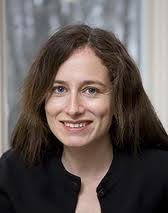
Liar Ruth Franklin
The Elie Wiesel of 2006 (and perhaps the Hasidic rebbes had something to do with this?) wants us to believe in the inviolable sanctity of the Jews’ “customs, mores and ancient laws,” and also in their innate respect for their elders and one another. But he is directly contradicted by what are, we are told, his own words of fifty years ago : “In the moment of danger, the chains of conventional morality fall away.” Which Wiesel do we believe?
And Ruth Franklin, senior editor at The New Republic, has the temerity to insist (toward the end of her 2006 review article) that “his [Elie’s] original suggestion that couples “copulated” in the cattle cars on the way to Auschwitz . . . was always a gross mistranslation of the original Yiddish.” We’ve shown you here that it isn’t.
3. Not yet fifteen … or fifteen?
UdV Page 63 : Yingl, vi alt bistu? fregt mir a heftling. Zeyn pnym iz geven in der fintster, ober zeyn kol iz geven a mids, a varems. Nokh nisht keyn 15 yor, hob ikh geentfert.
“Kid, how old are you?” a prisoner asked me. His face was in darkness, but his voice was tired and warm. “Not yet 15 years,” I answered.
LN Page 54: Hé, le gosse, quel âge as-tu? C’était un détenu qui m’interrogeait. Je ne voyais pas son visage, mais sa voix était lasse et chaude. “Pas encore quinze ans.” / Not yet 15 years.
SR Page 39: “Here, kid, how old are you?” It was one of the prisoners who asked me this. I could not see his face, but his voice was tense and weary. “I’m not quite fifteen yet.”
MW Page 30: “Hey, kid, how old are you?” The man interrogating me was an inmate. I could not see his face, but his voice was weary and warm. “Fifteen”
This very important passage was discussed above. I think the reader would agree that “not yet 15″ can mean even farther from the age of 15 than “not quite fifteen.” What is clear is that Marion Wiesel has changed the author’s original words to fit them to her husband’s age in Spring 1944.
4. April … or May?
UdV Page 83: A sheyner April-tog iz es geven. A frilings-rich in der luft. In English: It was a beautiful April day. A scent of spring in the air.
LN Page 69: C’était une belle journee d’avril. Des parfums de printemps flottaient dans l’air. Le soleil baissait vers l’ouest.
SR Page 49: It was a beautiful April day. The fragrance of spring was in the air. The sun was setting in the west.
MW Page 40: It was a beautiful day in May. The fragrances of spring were in the air. The sun was setting.
(See again When Did Wiesel Arrive) Once more, the original Night as translated by Stella Rodway agrees with the Yiddish and the French; Marion Wiesel arbitrarily changed April to May, yet said her translation did not “change the meaning or the fact of anything in the book” … what she calls a “significant change.” Well, this is a significant change, and for the same reason as given in number 1 above.
5. Himmler … or “Reichsfuehrer Himmler?”
UdV Page 124-5: “In nomen fun Himler . . . der heftling num’ . . . hot gegnbet . . . bsh”thn luft-alarm . . . loytn gezets, paragraf . . . iz der heftling num’ . . . farurteylt tsum toyt! Zol dos zeyn a lere un a beyshpil far ale heftlingen . . .”
“In the name of Himmler . . . prisoner number . . . stole . . . during the air raid . . . according to the law, paragraph . . . prisoner number . . . is condemned to death. May this be a lesson and an example for all prisoners.”
LN Page 100: “Au nom de Himmler ... Le détenu No… a dérobé pendant l’alerte… “
SR Page 68: “In the name of Himmler … prisoner Number … stole during the alert … According to the law … paragraph …prisoner Number … is condemned to death. May this be a warning and an example to all prisoners.”
MW Page 62: “In the name of Reichsfuehrer Himmler … prisoner number … stole during the air raid … according to the law … prisoner number … is condemned to death. Let this be a warning …..”
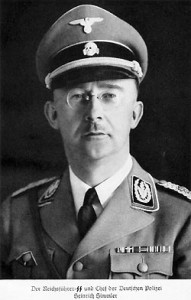
Reichsfuehrer SS Heinrich Himmler
Again, the Yiddish and the original Night agree. However, no trained member of the SS, or even the Wehrmacht, would ever have shown such disrespect as to use Himmler’s name in such a formal context without his full title: Reichsfuehrer SS Heinrich Himmler. Marion Wiesel tried to fix the error by adding “Reichsfuehrer,” but she still gets it wrong: you don’t drop the “SS.” On its own, this tells us that the speech was an imaginary one invented by the author (whoever that is), someone who was never present at such a scene. Indeed, lack of knowledge about how the SS functioned in the camps is evident throughout the book. For example, the SS did not normally go inside the barracks; everything inside was handled by the kapos.
6. Ten days and ten nights … or just “days and nights”
UdV Page 207: Tsen teg un tsen nekht hot gedoyert di reyze. / Ten days and ten nights the trip lasted.
LN Page 155: Dix jours, dix nuits de voyage. Il nous arrivait de traverser des localités allemandes.
SR Page101: Ten days, ten nights of traveling. Sometimes we would pass through German townships.
MW Page 100: There followed days and nights of traveling. Occasionally we would pass through German towns.
In January of 1945, as the advancing Red Army approached Auschwitz, a decision was made to evacuate, sending the prisoners to other camps in Germany. Evacuation of the Monowitz (Auschwitz III) camp, to which Eliezer and Father had previously been transferred, began at 6 p.m. on January 18. The prisoners were given extra clothing and food—bread to carry with them. They also had whatever food they had saved up. After marching all night during a snowfall, they rested in the morning in an old brick factory. In late afternoon, they began again and reached Gleiwitz camp in a few hours [night, Jan. 19]; they then remained in Gleiwitz barracks for three days. On the 22nd they went to the train stop and waited until evening. They were brought bread for the journey. The convoy set out
From there, as we see above, the Yiddish, the 1958 French and 1960 English versions agree on the trip lasting ten days and nights. But Marion Wiesel removes the number ten because it makes Eliezer’s timeline for the death of his father on Jan. 28/29 completely impossible. Another very significant change. Ten days and nights from the night of Jan. 22nd is the night of Feb 1, 1945.
This shows that the author of Un di velt knew nothing about the transport that arrived at Buchenwald on January 26 with 3000 prisoners from Auschwitz. This is the transport that, according to existing official records, brought Lazar and Abraham Wiesel to Buchenwald, who were registered at the camp there on . . . January 26, 1945! (See Buchenwald Archivist Cannot ID Elie Wiesel, How True to Life is Wiesel’s description of Buchenwald, and Gigantic Fraud Carried Out.)
7. Fifteen … or sixteen?
UdV Page 213: I was fifteen years old then. Do you understand—fifteen? Is it any wonder that I, along with my generation, do not believe either in God or in man; in the feelings of a son, in the love of a father. Is it any Wonder that I cannot realize that I myself experienced this thing, that my childish eyes had witnessed it? (This passage from Moshe Spiegel’s stand-alone translation of Chapter Six of Un di velt hot geshvign, published as “The Death Train” in the 1968 volume Anthology of Holocaust Literature.)
LN Page 158: J’avais quinze ans. / I was fifteen.
SR Page 103: I was fifteen years old.
MW Page 102: I was sixteen.
In the original versions, Eliezer repeats that he is fifteen years old in January 1945. Elie Wiesel’s birth date is Sept. 30, 1928 so on that day in 1944 he became sixteen years old, making him 16 years and 4 months when this particular event on the train to Buchenwald occurred in late January 1945. Once again, Marion Wiesel simply changes the age as she did before — if Elie was actually sixteen at that time, then Eliezer, the character in the book, must be too!
In Part Two, I will construct the timeline of the events in Buchenwald following the arrival of Eliezer and his father, and other details about Buchenwald. What will we find out? Stay tuned.
Endnotes:
1. On the back cover of the original hardcover Night, with the black & white striped jacket (as pictured here), it is printed “Literature” as the classification.
2. Ruth Franklin, A Thousand Darknesses: Lies and Truth in Holocaust Fiction, Oxford University Press, 2011, pp 71-72.
Unfortunately, Night is an imperfect ambassador for the infallibility of the memoir, owing to the fact that it has been treated very often as a novel—by journalists, by scholars, and even by its publishers. Lawrence Langer, in his landmark study The Holocaust and the Literary Imagination, notes that Night “continues to be classified and critically acclaimed as a novel, and not without reason.” . . .
Nonetheless, in 1997 Publishers Weekly columnist Paul Nathan had to issue a correction apologizing for referring to the book as an “autobiographical novel”; he had been misled, he said, by the entry on Wiesel in The International Dictionary of Twentieth-Century Biography. In response, the correction itself was challenged by the director of Penguin Reference Books, publishers of the biography dictionary, who cited half a dozen sources to the effect that Night was in fact a novel. Together with most critics, Gary Weissman, who recounted the above history in his book Fantasies of Witnessing: Postwar Efforts to Experience the Holocaust, seems to concur with Ernst Pawel’s remark in an early magazine survey of Holocaust fiction, that “the line between fact and fiction, tenuous at best, tends to vanish altogether in autobiographical novels such as Night.” The hybrid terms used to describe it include “novel/autobiography,” “non-fictional novel,” “semi-fictional memoir,” “fictional-autobiographical memoir,” “fictionalized autobiographical memoir,” and “memoir-novel.
GO TO PART TWO
19 Comments
Category Featured | Tags: Tags: Auschwitz-Birkenau, Buchenwald, Elie Wiesel, Holocaust fraud, Marion Wiesel, Monowitz, Night, Oprah Winfrey, Ruth Franklin, Un di velt hot geshvign,
Social Networks: Facebook, Twitter, Google Bookmarks, del.icio.us, StumbleUpon, Digg, Reddit, Posterous.
Friday, December 23rd, 2011
by Carolyn Yeager
copyright 2011 carolyn yeager
 Why is Grandma Nisel not mentioned in Elie Wiesel’s Night?
Why is Grandma Nisel not mentioned in Elie Wiesel’s Night?
According to Hilda Wiesel’s 1995 “Survivors of the Shoah” testimony, Grandmother Nisel (also spelled Nissel) went with the family to Auschwitz.
According to Elie Wiesel’s 1995 memoir, All Rivers Run to the Sea1, Grandmother Nisel went with the family to Auschwitz.
But Grandma Nisel is not mentioned even once in Wiesel’s 1958-60 supposedly autobiographical Night.2
Did Wiesel simply forget about his grandmother only 10 years after the event and then remember her again in the 1990’s? Did he cut her out because he wanted to condense his book and she was peripheral to the storyline? Neither of these can be believed. In the first place, Wiesel makes it clear in All Rivers how important Grandma Nisel was to him and he writes affectionately about her. Secondly, by including his grandmother when he mentioned his mother and three sisters, he would not have added more than a few words to the deportation narrative, as we will see. Thirdly, Grandma Nisel, as a member of his family group that he says he lost at Auschwitz, could not with any decency be left out when writing about this momentous event.
And, in fact, he didn’t leave her out of his memoir, nor did Hilda leave her out of her testimony. But Night is another story (pun intended).
There is no excuse or explanation that can be given for such a lapse, and none has ever been attempted. Not one of Wiesel’s numerous interviewers, biographers, commentators or adulators have ever asked about it, or, if they did, they must have accepted without complaint a “no comment” from him. (I suspect that whenever Wiesel gives an interview or allows someone to write a book about him, he obtains an agreement in advance as to what can be discussed and what is off-limits. And I imagine probing questions about his family are off-limits … probably on the grounds that it is “too painful” for him. Wiesel is always treated with the softest of kid gloves.)
Who is Grandmother Nisel and why is she important?
Nisel Bash was the daughter of Moshe and Yehudit (or Mindil) Bash (or Basch). She was born in 1881 in Chust, Ruthenian-Czechoslovakia. She married Eliezer Vizel and lived with him in Sighet, Rumania … which later became Hungary. (This information is from the victim forms filled out for Yad Vashem by her nephew and grandson; see further below.) We don’t know the date of her marriage, but her first child may have been born in 1900 when she was 19 years old. This first child of Nisel and Eliezer was probably a daughter, either Idiss or Giza. In 1903 their first son, named Shlomo, was born. After that came another son, Mendel; then two more daughters.
Below: YV forms for Shlomo Wiesel by Son Eli and cousin Yaakov Fishkovitz. (click on picture for larger image) Below that is the 1957 YV form for Mendel Wiesel by Yaakov Fishkovitz.
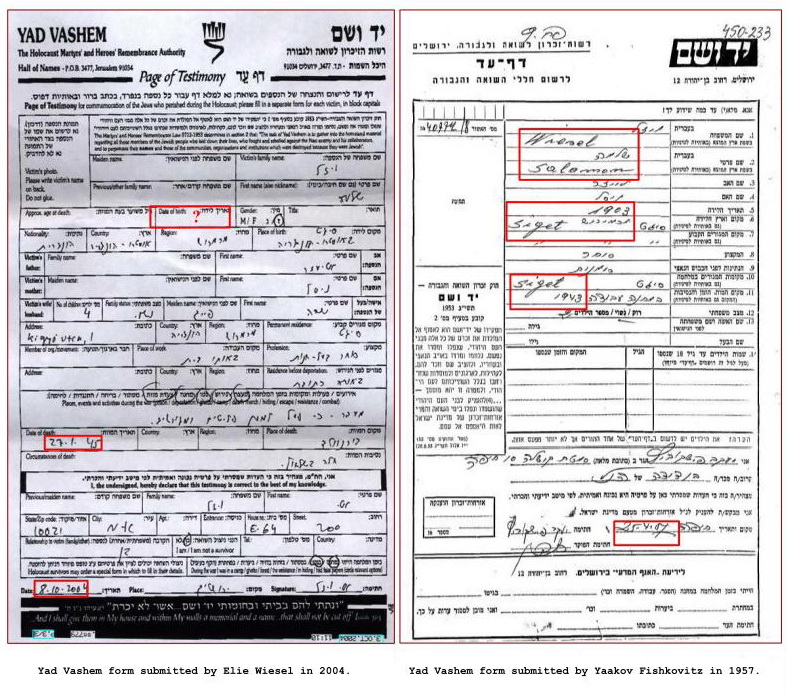
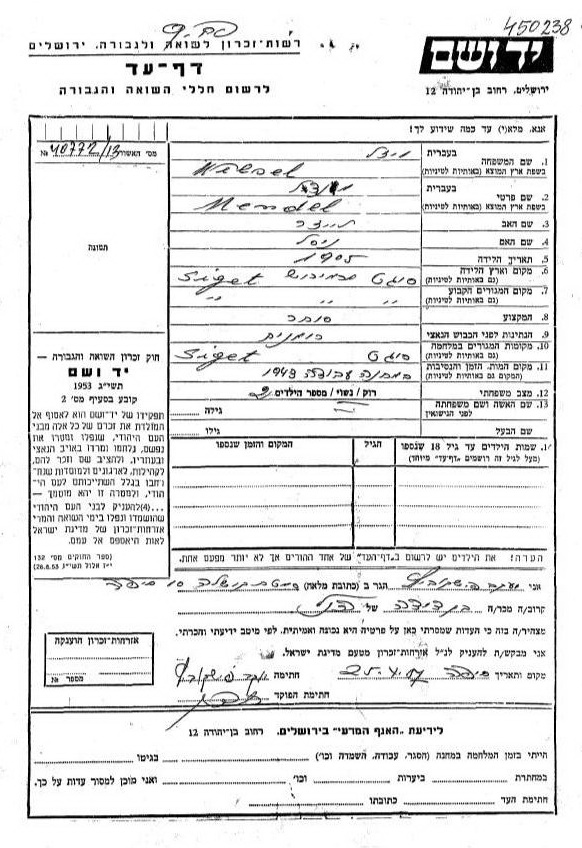 I have reconstructed the birth dates of Nisel’s children as best I can since no reliable family genealogy has ever been made available. Sites like Rootsweb are completely useless for information about the Wiesel family. In All Rivers (p. 7), Elie Wiesel writes about his aunts:
I have reconstructed the birth dates of Nisel’s children as best I can since no reliable family genealogy has ever been made available. Sites like Rootsweb are completely useless for information about the Wiesel family. In All Rivers (p. 7), Elie Wiesel writes about his aunts:
“I also had two aunts in Czechoslovakia: Aunt Idiss in Slotvino and Aunt Giza in Ungvaer. Grandma Nissel’s other two daughters lived in Sighet. Zlati, the youngest, was called an old maid behind her back. She married late, you see—at twenty-one.”
The older of the two daughters who lived in Sighet is never named or described, yet she could not have died as a child since Wiesel speaks of her as living in Sighet when he was a boy. Did she disgrace the family in some way and so is not to be mentioned? Wiesel writes that Grandma Nisel sat at the cash register in his father’s store, but also helped out at her son Mendel’s store:
“Maybe (Grandma Nisel) was trying not to show favoritism toward any of her children. My father was the oldest, but she was just as close to my Uncle Mendel, who had a modest grocery store on the other side of town.”
From this we can understand that Shlomo was the oldest of the two sons. Among Orthodox Hasidic Jews, males are in an entirely different category of importance and expectations than females, who are only required to find a good husband and have children. Mendel married Golda Feig, the sister of Sarah Feig, making for a tight-knit Wiesel-Feig family relationship.
Uncle Mendel Wiesel was born in 1905, according to cousin Yaakov (the only source we have) and died at the same time as Shlomo in 1943. He would have been only 38 years old! Yet in Night he appears in the story at the time of the deportation to Auschwitz—Elie Wiesel’s family stays in his empty house in the small ghetto. On page 30:
“The people must have been driven out unexpectedly. I went to see the rooms where my uncle’s family had lived. On the table there was a half-finished bowl of soup. There was a pie waiting to be put in the oven. Books were littered about on the floor. Perhaps my uncle had had dreams of taking them with him?”
Nisel lived in her own house that was close to her son Shlomo’s home. Young Elie dropped in often to visit her and had quite a few stories to tell about that in All Rivers. Elie’s namesake grandfather Eliezer had been killed in the First World War in his capacity as a stretcher-bearer. Nisel related to her grandson that when she was told of his death: “I learned what catastrophe meant, and I knew my mourning would never end.” (All Rivers, p 8)
On page 9, Wiesel relates a story that when he returned to Sighet as an adult, he first went to the cemetery to find his grandfather’s grave. He spoke to his grandfather’s spirit about the deportation to Auschwitz thus: “Did you know, Grandpa, that Grandma Nisel was the only one in the family, almost the only one in the whole community, who guessed it all? She knew she would never come home. She left this wretched town in her funeral dress. Yes, she wore her shroud under her black dress. She alone was ready.”
There are two other distinct mentions in All Rivers of his grandmother taking part in the deportation-to-Auschwitz process. On Page 70 he writes that on Tuesday, May 16, they were ordered out of their houses to be sent to the small ghetto. “There was another heat wave. My little sister was thirsty, and my grandmother too.” Page 77, arriving at Auschwitz: “I stared intently, trying desperately not to lose sight of my mother, my little sister with her hair of gold and sun, my grandmother, my older sisters.”
Yet in 20 pages in the book Night of detailed description of the pre-deportation events, the trip to Auschwitz and their arrival, there is no mention at all of a grandmother. Nowhere in the entire book is there a Grandma Nisel.
Other family members place Grandma Nisel at Auschwitz.
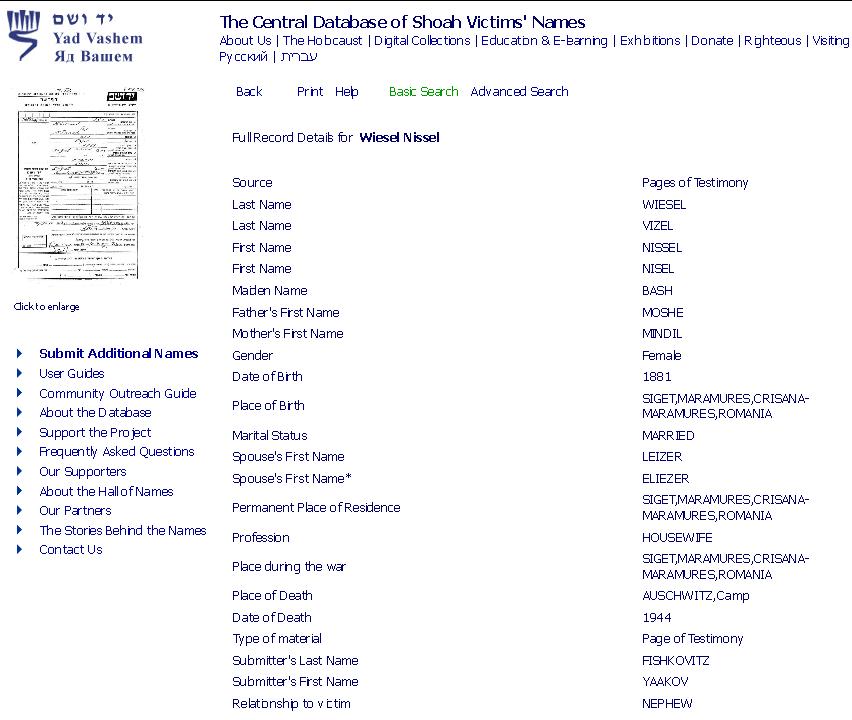
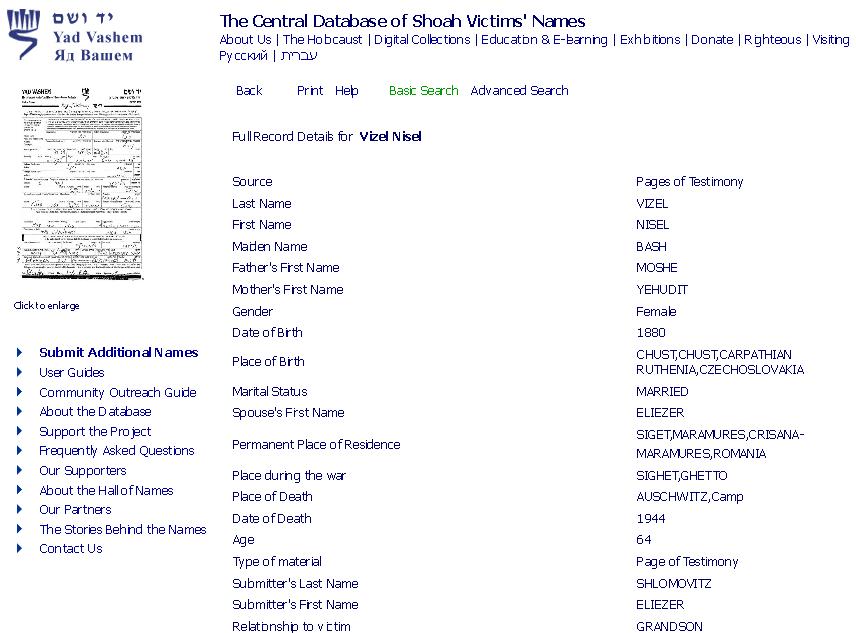
Her nephew Yaakov Fishkovitz in 1957 filled out a YV form (above top) stating she died at Auschwitz in 1944. Yaakov also filled out a form for his cousin Shlomo Wiesel. A grandson, Eliezer Shlomovitz of Los Angeles CA, filled out a Yad Vashem form for his grandmother Nisel Vizel too, many years later in 1994 or 1999 (hard to read), saying she died at Auschwitz in 1944 (above). But neither Elie nor his two surviving sisters acknowledged her death at Auschwitz in this way. Although Hilda said in her 1995 Shoah testimony: “… we were, myself and my sister, the one who was in Canada and is now deceased; my mother; my grandmother, that is my father’s mother; and, oh . . . my little 10-year old sister.”
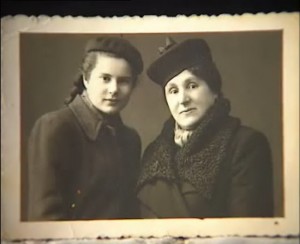 Hilda also said: “And my mother – died. She was 44 years old.” She then repeated: “And my little sister – dead at age 10.” These are assumed deaths. But if she is correct about her mother’s age in 1944, then Sarah Feig was born in 1900. Could she have been 3 years older than her husband, born in 1903 according to his cousin Yaakov? Possibly, even considering what we know about Hasidic marriages, wherein the groom is usually no more than one year older, or the same age, as the bride.3 But Hilda, being the eldest, should know her mother’s age. Right: Hilda, age 16, in 1938 with her mother Sarah Feig Wiesel, who would have been 38 in the picture if she were born in 1900.
Hilda also said: “And my mother – died. She was 44 years old.” She then repeated: “And my little sister – dead at age 10.” These are assumed deaths. But if she is correct about her mother’s age in 1944, then Sarah Feig was born in 1900. Could she have been 3 years older than her husband, born in 1903 according to his cousin Yaakov? Possibly, even considering what we know about Hasidic marriages, wherein the groom is usually no more than one year older, or the same age, as the bride.3 But Hilda, being the eldest, should know her mother’s age. Right: Hilda, age 16, in 1938 with her mother Sarah Feig Wiesel, who would have been 38 in the picture if she were born in 1900.
The name Shlomo appears only once in Night at the end.
On the very first page of this famous novel it is written: “My father was a cultured, rather unsentimental man.” Right here it would have been natural to write: My father, Shlomo Wiesel, was a cultured, rather unsentimental man. But no, and throughout the book this character continues to be known only as “my father,” until page 103-4 when another prisoner, Meir Katz, addresses him by his first name. In the original edition it is spelled Chlomo; in the 2006 translation, the spelling is changed to Shlomo. The name of Wiesel also occurs only once, on page 51:
We had already been eight days at Auschwitz. It was during roll call. We were not expecting anything except the sound of the bell which would announce the end of roll call. I suddenly heard someone passing between the rows asking, “Which of you is Wiesel of Sighet?
The man looking for us was a bespectacled little fellow with a wrinkled, wizened face. My father answered him.
“I’m Wiesel of Sighet.”
The little man looked at him for a long while, with his eyes narrowed.
“You don’t recognize me—you don’t recognize me. I’m a relative of yours. Stein. Have you forgotten me already? Stein! Stein of Antwerp. Reizel’s husband. Your wife was Reizel’s aunt. She often used to write to us … and such letters!”
Let’s remember there were many Wiesel’s (Vizel’s) in Sighet, a town with a large Jewish population. For example, there are three Mendel Wiesel’s from Sighet of around the same age in the Yad Vashem databank, and there are eight Shlomo Wiesel’s recorded as succumbing in the camps. This doesn’t include all the Wiesel’s with other first names! So we can expect that the man Stein would have used the first name too, or Wiesel would have asked Stein which Wiesel he was looking for. This seems like another avoidance of using the name Shlomo, but it is strange that both the first and last name were used one time only.
On page 2, the sisters are named:
There were four of us children: Hilda, the eldest; then Bea; I was the third, and the only son; the baby of the family was Tzipora.
In the original Night (p 31), the family servant, a Christian from a nearby village, is named Martha. In All Rivers, she becomes Maria, and the name in the 2006 re-translation of Night is changed to Maria. Okay, it could have been an error.
The dust jacket on an original, hard-bound copy of Night reads: “The adolescent Elisha and his family, among hundreds of thousands of Jews […] are cruelly deported …” Elisha is not the name of the main character in the book; it is Eliezer. The first time that name is used is on page 86: “Let’s hope that we shan’t regret it, Eliezer.” On page 92: “Don’t let yourself be overcome by sleep, Eliezer.” On page 96, Eliezer is addressed by his name twice by Juliek. On page 108: ”Eliezer … my son … bring me … a drop of coffee…” Then, again, on pages 109, 110 and 112. Why is he called Elisha on the dust jacket? Elisha is the name of the main character in Wiesel’s second novel, Dawn. A little mix-up there?
In Night, Father is 50 and little sister is seven.
In spring 1944, just arriving at Auschwitz, Eliezer’s father declares that he is fifty years of age. Eliezer says he is “not quite 15.” (p 40) In the new 2006 translation (p 30), Eliezer’s age is changed to “15” but the father’s “fifty” remains the same. “Not quite 15” doesn’t equate to Elie Wiesel, whose birthday is Sept. 30, 1928, so that was an oversight in Night. Or it can also be seen as a similar situation as with Tzipora’s age: Making the young victims even younger so they will appear more sympathetic to the reader, and making some adults older. Lying about their age is a tactic used by many “holocaust survivors” in their memoirs to explain how they escaped the “gas chamber.” Arguably, this could have been done by Sarah Wiesel for Tzipora too—claiming her to be 14 instead of 10, since in the story Night, Eliezer made himself out to be 18 (3 years older that he really was) and got away with it.
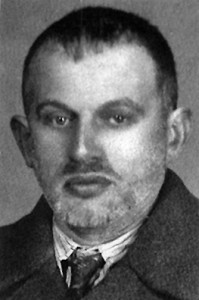 Why is the father in Night fifty? Shlomo Wiesel was certainly somewhere between 40 and 44 years of age in 1944. Actually, according to his cousin Yaakov, he wasn’t even alive, having died in 1943! Moreover, Mendel died in 1943 also. One has to assume from this that they died together somehow. Yaakov filled out a form for Mendel at the same time as for Shlomo. The forms look exactly alike except for the different name and date of birth. Shlomo is shown to be born in 1903, Mendel in 1905. Keep in mind that in 1957 the book Night was not yet published in French or English and the name of Elie Wiesel was completely unknown, so Fishkowitz had no reason to lie to protect his relatives, as he might have had later.
Why is the father in Night fifty? Shlomo Wiesel was certainly somewhere between 40 and 44 years of age in 1944. Actually, according to his cousin Yaakov, he wasn’t even alive, having died in 1943! Moreover, Mendel died in 1943 also. One has to assume from this that they died together somehow. Yaakov filled out a form for Mendel at the same time as for Shlomo. The forms look exactly alike except for the different name and date of birth. Shlomo is shown to be born in 1903, Mendel in 1905. Keep in mind that in 1957 the book Night was not yet published in French or English and the name of Elie Wiesel was completely unknown, so Fishkowitz had no reason to lie to protect his relatives, as he might have had later.
Contrarily, on the Yad Vashem form Elie Wiesel filled out in 2004, no birth date is given for his father, nor the age at death. Did he not know? Is it possible for a son not to know his father’s age?
This photograph (left) of Shlomo Wiesel was taken in 1942 according to Hilda Wiesel. At this time he would have been 39 years old.
Further, we have no information on these details for Wiesel’s mother Sarah Feig either, and no family member (or anyone) ever filled out a YV Holocaust victim form for her or her youngest daughter who supposedly died with her at Auschwitz. (Can the reason be that they don’t want to record an age/birth date for either one?) But, as I wrote above, Hilda Wiesel Kudler said in her Shoah testimony that her mother was 44 years old when she died, and her youngest sister was ten. Is Hilda a reliable witness?
On page 30 of Night, Eliezer says: “I looked at my little sister Tzipora, her fair hair well combed, a red coat over her arm, a little girl of seven.” This is when the family was walking to the ‘small ghetto’ after being ordered out of their home in the spring of 1944, only a week or so before they arrived in Auschwitz. But Hilda said Tzipora was then ten years old. Which is correct? Or is neither? Some of my readers will tell me, “What does it matter?” Accuracy matters, because if a source is wrong in some things that can be determined as wrong, nothing from there should be depended upon.
Nowhere in All Rivers do we find Tzipora’s age given by Wiesel, even though he mentions her many times. He only wants us to know that she was young or “a child.” A ten-year-old girl is quite a bit more mature than a seven-year old. I venture to say she was given the age of seven in Night to make her appear more vulnerable, and her death even more of a barbaric crime. Also, if she were seven, there would be more reason to “exterminate” both mother and daughter, under the extermination thesis. But in truth, a 44-year-old-woman and her 10-year-old daughter could be quite useful in the labor force, and therefore could have gone on to meet some other fate. There may even be some private knowledge of that—which may be another reason no one has filled out a Yad Vashem Holocaust Victim report for these two, while two were filled out for 64- year-old Grandma Nisel.
That Shlomo Wiesel was 50 years old in 1944 can be ruled out by the fact that his mother was 64 years old in 1944, making her only 14 years older than a 50 year old. So this Father character cannot truly be the real Shlomo. The father is depicted as somewhat confused, a poor decision maker, and as having difficulty adjusting to camp life, both physically and psychologically. He appears more like a man of sixty. Eliezer is often shown to be his father’s caretaker. “My father … was running at my side, out of breath, at the end of his strength, at his wit’s end. I had no right to let myself die. What would he do without me? I was his only support.” (Night, p 90)
A fifteen-year-old with a gold crown?
How many 15-year-olds do you know who have a crown on a tooth already? Thirty-one-year-olds may, the age Lazar Wiesel was in 1944. Or the following story could be totally fabricated. Wiesel writes in Night that when he was transferred to Monowitz (Buna), he was given a physical and a dental exam. The dentist wanted to remove his gold crown; Eliezer talked him out of it. One day his work foreman, named Franek, noticed the gold and told Eliezer he wanted it. Eliezer resisted, but eventually, after suffering a series of abuses, gave up his gold tooth to Franek. In this story, he is called out for his dental appointment by his number, “A-7713.” (p 58) The number is used again on page 64 when the Kapo decides to give him a beating.
I felt the sweat run down my back.
“A-7713!”
I came forward.
Earlier, on page 51, the author wrote:
“The three “veterans,” with needles in their hands, engraved a number on our left arms. I became A-7713.”
Yet where is the number A-7713 on Elie Wiesel’s left arm?
At Buna, he worked in an electrical warehouse alongside some Polish civilians and a few French women After his beating by the Kapo, one of the French girls came over to him, “wiped his blood-stained forehead with her cool hand,” gave him a mournful smile and a bit of bread. Finally she spoke to him “in almost perfect German.” Several years later he recognized her in the Paris Metro, and prodded her memory. They went to a terrace café and she revealed to him that she was Jewish, from a religious family, and during the occupation she obtained forged papers and passed herself off as an Aryan. She was enlisted in “forced labor groups” and deported to Germany. That’s how she escaped the concentration camps.
These kinds of stories abound in Night and other holocaust-survivor books. No witnesses, no proofs, no names, just a bit of imagination. I will remind you again that the original Night was published in 1960 categorized as Judaica/Literature … in other words, fiction. When the new translation came out in 2006, it was changed to Autobiography/Jewish Interest. It is now an autobiography of Elie Wiesel, with his picture on the back cover and a special new Preface, written by him, which condemns the Germans and attempts to explain the changes he and his wife have made in the text.
Eliezer Wiesel is not necessarily Elie Wiesel
The author of the Yiddish book is Eliezer Wiesel. The author of Night is Elie Wiesel. There is only 2 years between the publication of Un di Velt Hot Gesvign in 1956 and the French La Nuit in 1958, but in that time the author’s name had changed. When did Elie start being called ‘Elie’ rather than Eliezer or Liezer or Lazar or something else? According to some of his biographers, it was when he was still living at home with his family. As we know, there were many Eliezer Wiesel’s (Vizel’s) in Sighet, let alone in Hungary, at the time. Un di Velt Hot Gesvign, however, was written in Polish Yiddish, or at least it was published in that language. The final version of the book of 245 pages was edited by Mark Turkov who specialized in Polish Yiddish. Where the story came from, we really don’t know. That’s the bottom line. We have the preposterous story told by Elie Wiesel of writing it in a ship’s cabin on his way to Brazil at a time that he was involved in a serious love affair and embarking on an important assignment for his newspaper. Equally preposterous is his claim to have handed an 862-page manuscript over to the stranger Turkov during a chance meeting on the ship, docked at Sao Paulo, without a copy for himself or a contract or any guarantee of return – just ‘good faith.’ Being an experienced journalist at that time, he would certainly have known better. Worse than that, he says he didn’t even believe when he gave it to him that Turkov would publish it. (All Rivers, p 240-41)
We make a leap of faith to believe that Eliezer Wiesel has to be Elie Wiesel. It should also be pointed out that these survivor stories were all the rage within the Yiddish-speaking communities at the time. There were many of them in circulation, even before they were published. Elie Wiesel had cousins in Argentina whom he visited while he was there in April-May 1954; he mentioned them in All Rivers.4 It’s very likely that he was introduced to these survivor stories, and Mark Turkov’s publishing house, through these relatives and their circle. Was he attracted to a particular story by an author with his own name, Eliezer Wiesel?
More unlikely stories
Wiesel tells us another unlikely story in All Rivers (p 277) that in Dec. 1955, back in Paris, he received a copy of the published book, edited down to 245 pages, in the mail from Turkov. There are no witnesses to this. He only mentions telling one close friend, Israel Adler, who took him out for a coffee by way of celebration.(!) Shortly after that he moved to the United States. It appears from his writings that Wiesel forgot all about the manuscript he gave to Turkov until the book came to him in the mail, but he does add on that page that “they never did send back the manuscript”—to give himself a reason for not having it and not being able to say what was actually in it.
In contradiction to this story is the one wherein Francois Mauriac, whom Wiesel first meets in Spring 1955, encourages him to write about his concentration camp experiences. He doesn’t tell Mauriac he has already done so, but acts like he will think about it, later accepting the guilt-ridden, elderly Catholic’s help in getting the book published. Wiesel writes in All Rivers, p 319, that he sent a manuscript of what became La Nuit (Night) to Mauriac one year later, in 1956.
In 1957, during my convalescence, I received good news from Francois Mauriac: Jerome Lindon of Editions de Minuit was going to publish La Nuit (Night). The letter of confirmation opened a new chapter in the book of commentaries that is my life.
Lindon didn’t like the orginal title: “And the World Remained Silent.” He preferred a biblical phrase, perhaps something from the Book of Jeremiah. But after discussing various suggestions, we settled on La Nuit. Lindon also wanted me to tighten the text, given to him by Mauriac, though I had already pruned and abridged it considerably.
The text was given to the French publisher by Mauriac. In the following lines he says that he, Elie, was the one who made the drastic cuts in the original manuscript. When?!
He proposed new cuts throughout, leading to significant differences in length among the successive versions. I had cut down the original manuscript from 862 pages to the 245 of the published Yiddish edition. Lindon edited La Nuit down to 178.
What a tissue of lies. Never before had Wiesel written about the Yiddish book, but now, in 1995, he relates that it was he who cut the 862 pages to 245. Such a prodigious task would certainly not have gone unremarked upon by him! And now it is the publisher Lindon who did the final editing to 178 pages. One wonders just what part Elie Wiesel played in this group effort?
Wiesel continues with an unconvincing “explanation” of why the book’s original ending was cut out, something that was made controversial by a certain Jewish scholar. He then says, “By the time Night was published in France, I was at work on another book.” This rendition of how such an important book came about is so sloppy and insulting to the intelligence of his readers that it speaks for itself.
Both the USHMM and Wikipedia have the dates wrong.
At the United States Holocaust Memorial Museum Elie Wiesel Timeline: From 1952, it says Wiesel interviewed Mauriac in 1954 (it was 1955) and that Wiesel finished his “900-page Yiddish manuscript” in Brazil in 1955 (it was 1954). I believe it is backwards on purpose, in order to fit Wiesel’s lies. But this is typical of the scholarship carried out at this totally Jewish-run, but partially government-funded museum. It reads:
1954
During an interview with the distinguished French writer, Francois Mauriac, Elie is persuaded to write about his experiences in the death camps.
1955
Elie Wiesel finishes a nearly 900-page manuscript in Yiddish while on assignment in Brazil. And the World Stayed Silent is published in Buenos Aires, Argentina.
1963
Elie Wiesel becomes an American citizen.
Wikipedia skips over the dates, doesn’t give any dates for the writing of the books because they don’t fit, but says that Wiesel moved to NYC in 1955.
“In 1955, Wiesel moved to New York City, having become a US citizen: due to injuries suffered in a traffic accident, he was forced to stay in New York past his visa’s expiration and was offered citizenship to resolve his status.”
Others say he moved to NYC in 1956. Since he was still in Paris in Dec.’55, one assumes he didn’t leave for the U.S. until Jan. ‘56. Wiesel nowhere gives a date, which is the reason for the confusion — his biographers have to guess. But, while he received a U.S. “green card” sometime after recovering from his accident, he did not become a citizen until 1963. Wikipedia is known to change its information on Wiesel without notice. For example, it now spells his father’s name Chlomo, whereas previously it was Shlomo.
Why did Wiesel start campaigning for the Nobel Prize the same year Mark Turkov died?
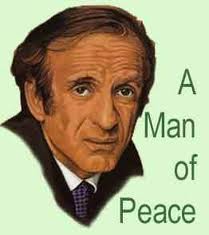 Mark Turkov, the publisher of Un di Velt Hot Gesvign (And The World Remained Silent), died in 1983, the same year Wiesel’s supporters began their campaign to get him a Nobel Prize. It is a fact that Wiesel never spoke about the Yiddish book that was the precursor to Night until after Mark Turkov’s death. As I wrote in “The Shadowy Origins of Night, Part III,” this was the time Wiesel first began to speak of being the author of the Yiddish book, which he obliquely referred to in his Nobel Prize acceptance speech in 1986, when he said “the world did know and remained silent.”
Mark Turkov, the publisher of Un di Velt Hot Gesvign (And The World Remained Silent), died in 1983, the same year Wiesel’s supporters began their campaign to get him a Nobel Prize. It is a fact that Wiesel never spoke about the Yiddish book that was the precursor to Night until after Mark Turkov’s death. As I wrote in “The Shadowy Origins of Night, Part III,” this was the time Wiesel first began to speak of being the author of the Yiddish book, which he obliquely referred to in his Nobel Prize acceptance speech in 1986, when he said “the world did know and remained silent.”
Another reason for bringing the previously ignored Yiddish book into the light is that Buchenwald survivor Myklos Grüner began, in 1987, to claim that a different Eliezer Wiesel was the author of Un di Velt Hot Gesvign, thus making it necessary for the first time for Elie to explain just how it got written … by him. That he botched the explanation so badly in his memoir is no surprise to those who have studied the man. From the article mentioned above:
Grüner writes in his book Stolen Identity (p 50), “My work of research to find Lazar Wiesel born on the 4th of September 1913 started first in 1987, to establish contact with the Archives of Buchenwald.” He was also writing to politicians and newspapers in Sweden. This could not have failed to attract the notice of Elie Wiesel and his well-developed public relations network. Grüner tracked down Un di Velt Hot Gesvign as the original book from which Night was taken, and believed it was written by his friend Lazar Wiesel and stolen somehow by Elie. (p 43)
This could account for why Elie Wiesel suddenly began to speak and write about ‘his’ Yiddish book, published in Buenos Aires, Argentina in 1956. He deals with it in his memoir All Rivers, published in 1995, after Turkov and everyone else associated with it are dead. No witnesses.
Is it too far-fetched to believe that Turkov agreed to remain silent about the real author of Un di Velt Hot Gesvign, either by being bought off, threatened, or even voluntarily? And once Turkov was safely dead, Wiesel and his supporters could breathe more easily about claiming his authorship of the book.
It is a strange fact that the title Un di Velt Hot Gesvign (or, in English, And the World Remained Silent) does not appear on the long list of “books by Elie Wiesel” at the beginning of his memoir All Rivers, nor in the original or in the new 2006 translation of Night. It also does not appear in the complete list of his books at The Elie Wiesel Foundation for Humanity. It is, however, at the beginning of the list of his books on Wikipedia. Clearly, there is uncertainty about this book, perhaps a desire by publishers not to put down in writing something that could bring them a lawsuit … or perhaps a wish by Wiesel not to stimulate questions about that book.
Conclusions
1. The characters in Night are only loosely based on Elie Wiesel and his family. Therefore it can’t be called an autobiography.
2. Elie Wiesel is the author of Night, written in French with the assistance of his editor and probably Francois Mauriac, but he is probably not the author of Un di Velt Hot Gesvign.
3. Elie Wiesel made arrangement while in Brazil/Argentina for Mark Turkov to mail him the book by Eliezer Wiesel as soon as there was a hard copy, or his relatives mailed it to him. (Elie received a copy in Dec. 1955, according to himself, but the book was not available to the public until 1956.)
4. In the winter and spring of 1956, in the United States, Elie adapted the book to a shorter version in French, which he mailed to Francois Mauriac in Paris. He inserted the names of his family members and personalized it, especially in the beginning chapters.
5. The secrecy of the birth and death dates among Wiesel’s close relatives is to keep from contradicting what is written in Night, on which his fame and fortune truly rests. Without Night, Wiesel fades into just another Jewish-Zionist writer.
6. Elie Wiesel’s failure to correct and clarify details of his family history (especially birth and death dates of his parents, sisters and other close relatives), and of the writing and publication of Un di Velt and La Nuit, mirrors his refusal to show the number A-7713 that he says is tattooed on his left arm.
7. The essential purpose for securing a Nobel Prize for Wiesel, in literature or peace, was to solidify his reputation in light of the fragility of Night as the basis of that reputation. Nobel prize recipients are a protected species by the entire “global elite,” not just the Jews. Having himself falsely identified in the Buchenwald Liberation photo served the same purpose.
My challenge: I welcome any native Polish Yiddish speaker/reader who is also fluent in English to prove me wrong about what I have written above by providing an honest, accurate translation of Un di Velt Hot Gesvign into English so it can be compared with Night. Why hasn’t this already been done? It’s natural to be suspicious of what is kept hidden. Let’s put everything on the table so that the questions I have raised can be cleared up.
Endnotes:
1. Elie Wiesel, Memoirs: All Rivers Run to the Sea, Alfred A. Knopf, New York, 1995. 418 pp.
2. Elie Wiesel, Night, Hill and Wang, New York, 1960. 116 pp. (Original edition)
3. “One day my father saw a beautiful young girl in a carriage and was so struck by her that he ran after her, calling out, ‘Who are you?’ Of course, she did not deign to reply, but that evening the driver gave him the answer. The girl was the younger daughter of Reb Dodye Feig, of the village of Bichkev. The following year they were married, and they had four children, three girls and a boy.” (All Rivers, p 15)
4. “In Buenos Aires my cousins Voicsi and her husband Moishe-Hersh Genuth came to meet us. I gave them some articles for Yedioth Ahronoth, unaware they would be reprinted or quoted in the American Jewish press.” (All Rivers, p 241)
20 Comments
Category Featured | Tags: Tags: Elie Wiesel, Grandmother Nisel Wiesel, Hilda Wiesel, Holocaust fraud, Mendel Wiesel, Night, Shlomo Wiesel, Tzipora Wiesel, Un di Velt Hot Gesvign,
Social Networks: Facebook, Twitter, Google Bookmarks, del.icio.us, StumbleUpon, Digg, Reddit, Posterous.
Monday, September 12th, 2011
By Carolyn Yeager
Proof that the man in the famous Buchenwald photograph is NOT Elie Wiesel.
With the help of the New York Times and the U.S. Holocaust Memorial Museum, Elie Wiesel and his backers did not shy away from criminal deceit by purposely misidentifying an unknown face in this famous photo as belonging to Elie Wiesel.
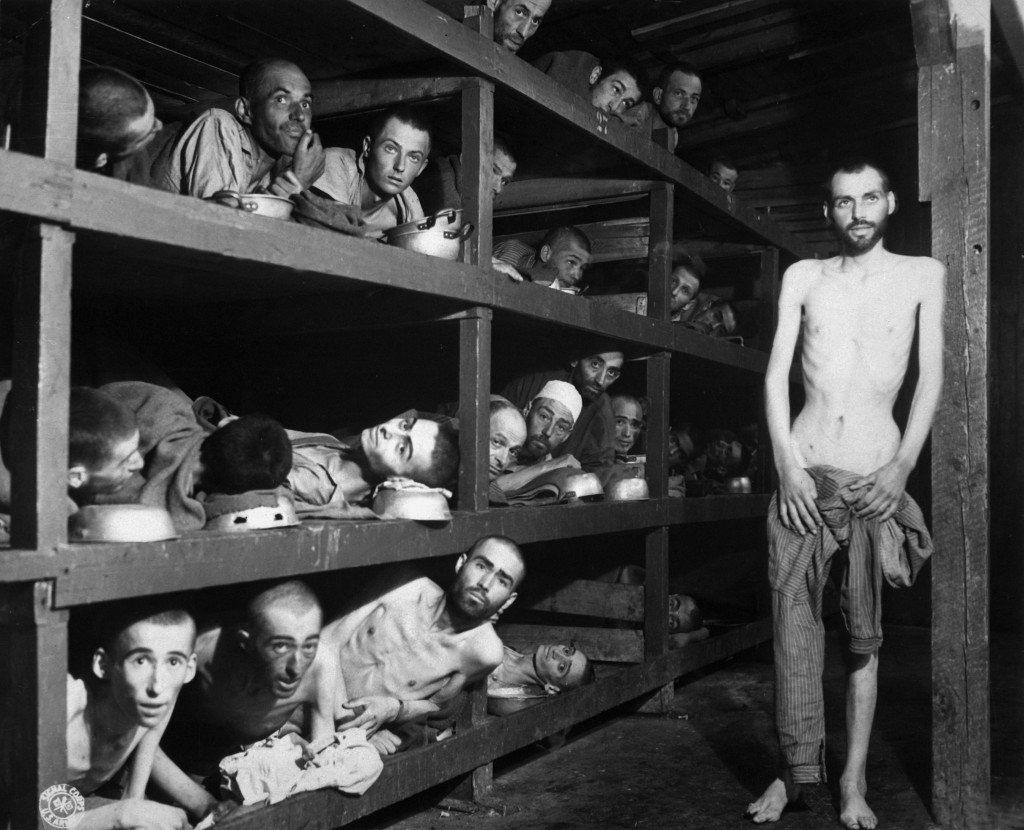
The above high-resolution photograph of Buchenwald survivors was first published in the New York Times on May 6, 1945 with the caption “Crowded Bunks in the Prison Camp at Buchenwald”. [click on image twice to enlarge fully] It was taken inside Block #56 by Private H. Miller of the Civil Affairs Branch of the U.S. Army Signal Corps on April 16, 1945, five days after the Buchenwald camp was liberated by a division of the US Third Army on April 11, 1945. None of the men in the picture were identified at that time.
The U.S. Army photographer was in block #56, not #66
The U.S. Army photographer said he was inside Block #56. The “children’s block” that housed the so-called “boys of Buchenwald” was #66. This was not a typo. Note that these men are not children or teenagers, except for the youngster on the lower left who has been correctly identified as 16 yr. old Myklos (Nikolaus) Grüner, and maybe a couple others. These adults appear to be a mixture of sick individuals suffering from a wasting disease (Grüner learned after liberation he had TB), along with basically healthy men who were also in that block, for some unknown reason, five days after they had been freed. As we have read from many Buchenwald inmates, they moved about at will from the day of liberation onward. In Elie Wiesel’s book Night, he even says that some of the boys in his block went to the city of Weimar the very next day to steal potatoes and rape girls.
The true facts of this photograph have never been told and perhaps are not known. (Grüner has written in Stolen Identity that he left a procession of youths being led to the camp entrance on the morning of April 11, scurried into the nearest barracks and jumped into an empty bunk space. It turned out to be this one.) But because of the man standing there stark naked except for a piece of clothing held in his hands to cover himself, this photograph was certainly staged. In any event, it was never represented as the “children’s barracks.” Still, Elie Wiesel inexplicably once told an interviewer for the German weekly Die Zeit that this photograph was taken in the Children’s Block and all these men were really teenagers even though they looked old. (Source: “1945 und Heute: Holocaust,” Die Zeit, April 21, 1995.)
Kenneth Waltzer wrote to this website EWCTW on Nov. 14, 2010: “Eli Wiesel was indeed the Lazar Wiesel who was admitted to Buchenwald on January 26, 1945, who was subsequently shifted to block 66…” and Waltzer repeated in another comment on June 27, 2011 that “— after his father died — Elie Wiesel was moved in early February to block 66, the kinderblock. Miklos Gruner too was in block 66. Elie Wiesel was there with other boys from Sighet, who knew him.”
But we are also to accept that on April 16 Wiesel was in block 56, even though he didn’t report any such move in his book Night. In fact, in that fictitious story, Wiesel says he became deathly ill with food poisoning three days after liberation (April 14) and spent the next two weeks in hospital (pg 115, Marion Wiesel translation). That in itself precludes his being in this photograph taken on April 16!
Whom do you believe—the New York Times or your own eyes?
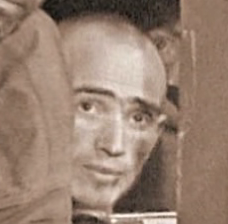
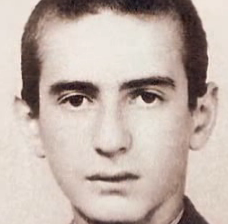 Not Wiesel at age 16 in 1945
Not Wiesel at age 16 in 1945
You can see for yourself from these two high-quality photographs supplied to me by a helpful reader that the face on the left is not Wiesel. A close inspection of the prisoners in the bunks in the famous photograph reveals that the eyebrows on many (including the one on the left above) were emphasized with a dark crayon/pencil … in other words, retouched or “photo-shopped.” On the right is what is claimed to be Elie Wiesel in 1944 at the age of 15.
The inmate on the left definitely has an aquiline nose and full, even sensual, lips. In this close-up, the receding hairline is visible on the recently shaved head. On the right, the real 15-year-old Elie Wiesel exhibits a normal youthful hairline, a bigger and longer nose and thinner lips. He also has a higher forehead and longer face than the more roundish-headed inmate. The eyes of the man on the left are not as deep-set under the eyebrows. His somewhat surprised, curious expression is not typical of Wiesel, whose expression was generally reserved, and often hooded.
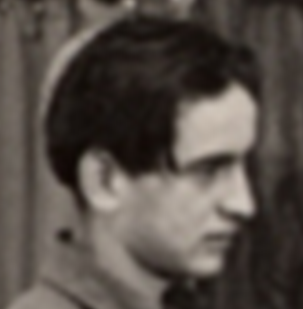
The close-up on the left appears to be the real Elie Wiesel in France later in 1945. He would be 17 or almost 17 years old in this picture. Notice the non-receding, youthful hairline with a very long front lock hanging to the side, and the straight nose .
This close-up image is from the photograph below, which is found at the USHMM Survivor Resource Center with the caption given below. (click here or on lower pic for an undistorted, larger image)
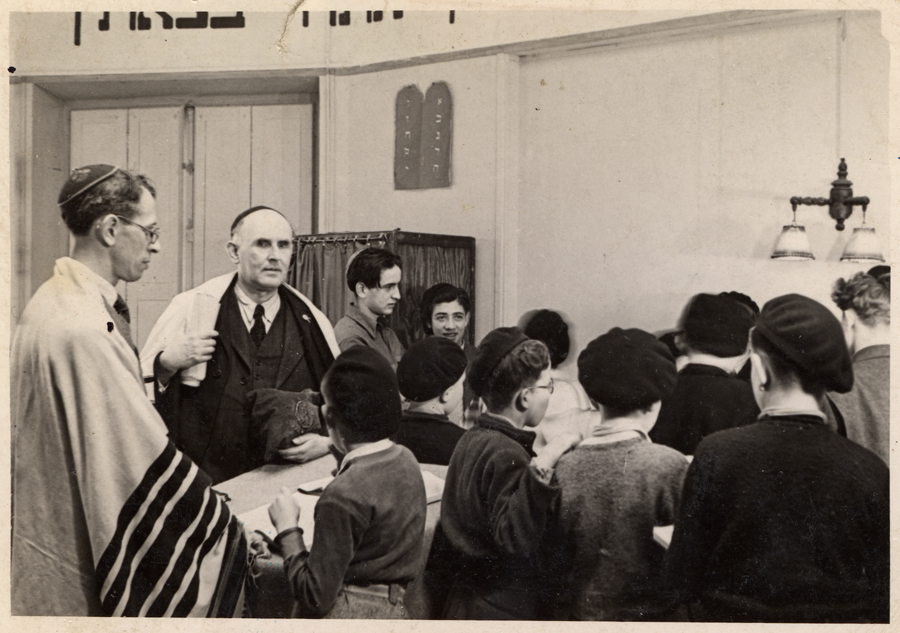
Above, Jewish boys gather for a prayer service in a chapel in an OSE children’s home in 1945. Those pictured include Elie Wiesel (seen in profile) and Jakob Rybsztajn standing next to him facing the camera. (I note that Elie Wiesel is older than the other boys in this picture, giving support to the idea that he acted in the role of counselor and sometime teacher to the newer, younger religious boys.)
Notice again the straight nose, the high forehead, deep-set eyes, large ears, sensitive mouth and slender neck. But also look at all that hair! The date of this picture is given by USHMM as 1945 and the location as Ambloy, [Loir et Cher] France. It says in the accompanying text “In October 1945 the children and staff of Ambloy were relocated to the Chateau de Vaucelles in Taverny (Val d’Oise).” That means this picture was taken between June and October 1945. They could have been celebrating Rosh Hashana, Yom Kippur or Sukkot.
But could his hair have grown to such a length from a shaved head in April 1945? No way, and thus we have another proof that the liberated Buchenwald inmate with the shaved head is NOT Elie Wiesel.
A PDF from my valued contributer examines the ages of the small group more closely. In my opinion, he has the ages of all four men a little too young but especially #2 and 4. Take a look: four men in bunk
Who first identified Elie Wiesel in the famous Buchenwald liberation photo?
In October 1983 the Jewish-owned New York Times published this photograph as part of an article in its high circulation Sunday NYT Magazine with the caption: “On April 11, 1945, American troops liberated the concentration camp’s survivors, including Elie, who later identified himself as the man circled in the photo.”
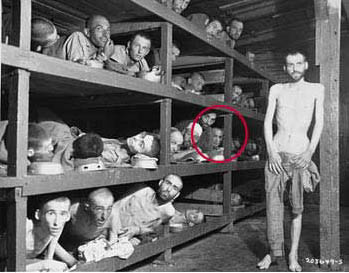
It was also in 1983 that Wiesel’s friend Sigmund Strochlitz began campaigning for a Nobel prize for Wiesel. Letters of nomination are due into the Nobel committee by Feb.1 of each year, so by January 1984, the committee was receiving letters nominating Wiesel from U.S. Senators such as Daniel Moynihan and Barry Goldwater (both Jewish). [see “How Elie Wiesel Got the Nobel Peace Prize“] The effort continued, with new and ever more innovative ideas, through 1985 and 1986 with the help of Jew John Silber, President of Boston University, Wiesel’s employer. Hundreds were enlisted into the effort.
The 1983 article in the New York Times that was the opening gun of the campaign was written by Jew Samuel Freedman and titled “Bearing Witness: The Life and Work of Elie Wiesel.” It included this line: “His name has been frequently mentioned as a possible recipient of a Nobel Prize, for either peace or literature.” Well, it had just begun to be mentioned … by this team of cheerleaders.
Wiesel pretends that he had nothing to do with it. In an interview in France in 2009, he said: “If you fight or if you do scientific research to get the Nobel, you never succeed and you should not succeed.” (Elie Wiesel, “messager de la memoire”) No, he did not fight but his mercenaries fought for him, and he used this photograph as his “research.” That this photograph played a large role is shown by the fact that immediately after the Nobel award ceremony in December 1986, Wiesel went to Yad Vashem Memorial in Jerusalem and posed in front of its prominent display there.
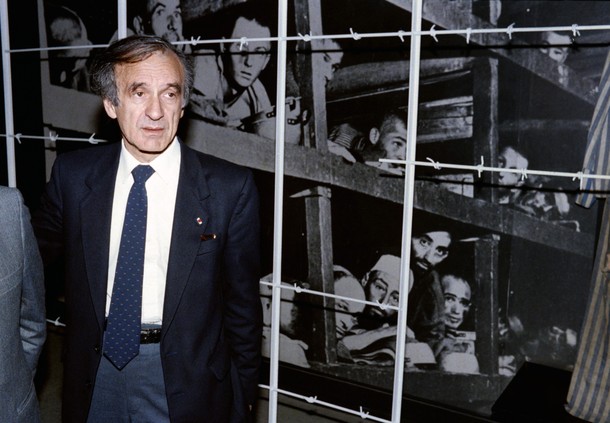
Elie Wiesel on Dec. 18, 1986 at Yad Vashem in Jerusalem
After the award was announced by the Nobel Committee, the New York Times published on Nov. 1 a severely cropped version of the Buchenwald photo (below) with the caption: “Elie Wiesel, the winner of the Nobel Peace Prize (at far right in the top bunk) in the Buchenwald concentration camp in April 1945, when the camp was liberated by American troops.” The picture accompanied an article by Jew Martin Susskind titled, “A Voice from Bonn: History Cannot Be Shrugged Off.”
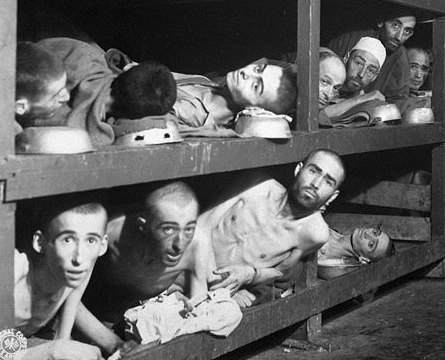
The role played by the tax-payer funded United States Holocaust Memorial Museum
Elie Wiesel finagled his way to becoming Founding Chairman of the United States Holocaust Memorial Council in 1980 after being chosen in 1978 by President Jimmy Carter as chairman of the President’s Commission on the Holocaust. Why the United States needed to do anything at all about the “Holocaust” is something only the 2.5% Jewish population in this country can answer. It is to satisfy them. Wiesel continued to chair the Council until 1986, when he reached his goal of becoming a Nobel Laureate. The USHMM was undoubtedly an important institutional heavyweight that leveraged him to the Nobel.
The USHMM naturally accepted that Wiesel was in the famous photograph as soon as he and the New York Times said he was. If you think the museum staff does real research, is searching for truth and/or is engaged in scholarship of any kind, you are badly mistaken. The museum represents official power only and is invested in keeping it in Jewish hands.
This photograph is the only document tying Elie Wiesel to the Holocaust
The only document that connects Elie Wiesel to the Auschwitz-Birkenau and Buchenwald experience he claims to have—in other words, his claim to be an authentic “Holocaust survivor”—is the famous Buchenwald liberation photograph. There are no records with his name and birth date for either camp. His books do not support his presence there very well. That’s why the Wiesel promoters, who wanted to anchor their man’s claim to be the unchallenged spokesman for the world’s greatest victims—which winning a Nobel prize would surely do—decided that they could pawn that unknown face off as the face of Wiesel. This decision was made in 1983. It’s certain that Elie Wiesel took part in making it, though the pretense is kept up by all that he was aloof from the entire process.
What you must do
When you comprehend the immense power that this simple photo comparison and commentary gives us, you know that we have it in our hands to break down the Wiesel legend if this knowledge is widely circulated. If you understand this, you know what you must do. You must post this article everywhere you can, you must tell everyone about it, send it to all you know … make sure that this photo comparison moves through the Internet and finds a home in as many places as possible. And keep it up, because once is not enough. I’ve done my part, readers. Now it’s up to you.
54 Comments
Category Featured | Tags: Tags: Ambloy France, Block 66, boys of Buchenwald, Buchenwald liberation, Elie Wiesel, Holocaust fraud, Ken Waltzer, Myklos Gruener, New York Times, Nobel Peace Prize, OSE, US Holocaust Memorial Museum, USHMM,
Social Networks: Facebook, Twitter, Google Bookmarks, del.icio.us, StumbleUpon, Digg, Reddit, Posterous.
 Left: Henry Fenichel, top speaker, wears a yellow Star of David while conducting a presentation to students.
Left: Henry Fenichel, top speaker, wears a yellow Star of David while conducting a presentation to students.


































